D Link HP1320A1 Wireless N Powerline Router User Manual Part 1
D Link Corporation Wireless N Powerline Router Part 1
D Link >
Contents
- 1. User Manual Part 1
- 2. User Manual Part 2
- 3. User Manual Part 3
User Manual Part 1

1D-Link DHP-1320 User Manual
Section 1 - Product Overview
Product Overview
Note: Using a power supply with a dierent voltage rating than the one included with the DHP-1320 will cause damage and void the
warranty for this product.
Package Contents
DHP-1320 Wireless N PowerLine Router
Ethernet Cable
Two Detachable Antennas
Power Adapter
CD-ROM with Manual and Setup Wizard
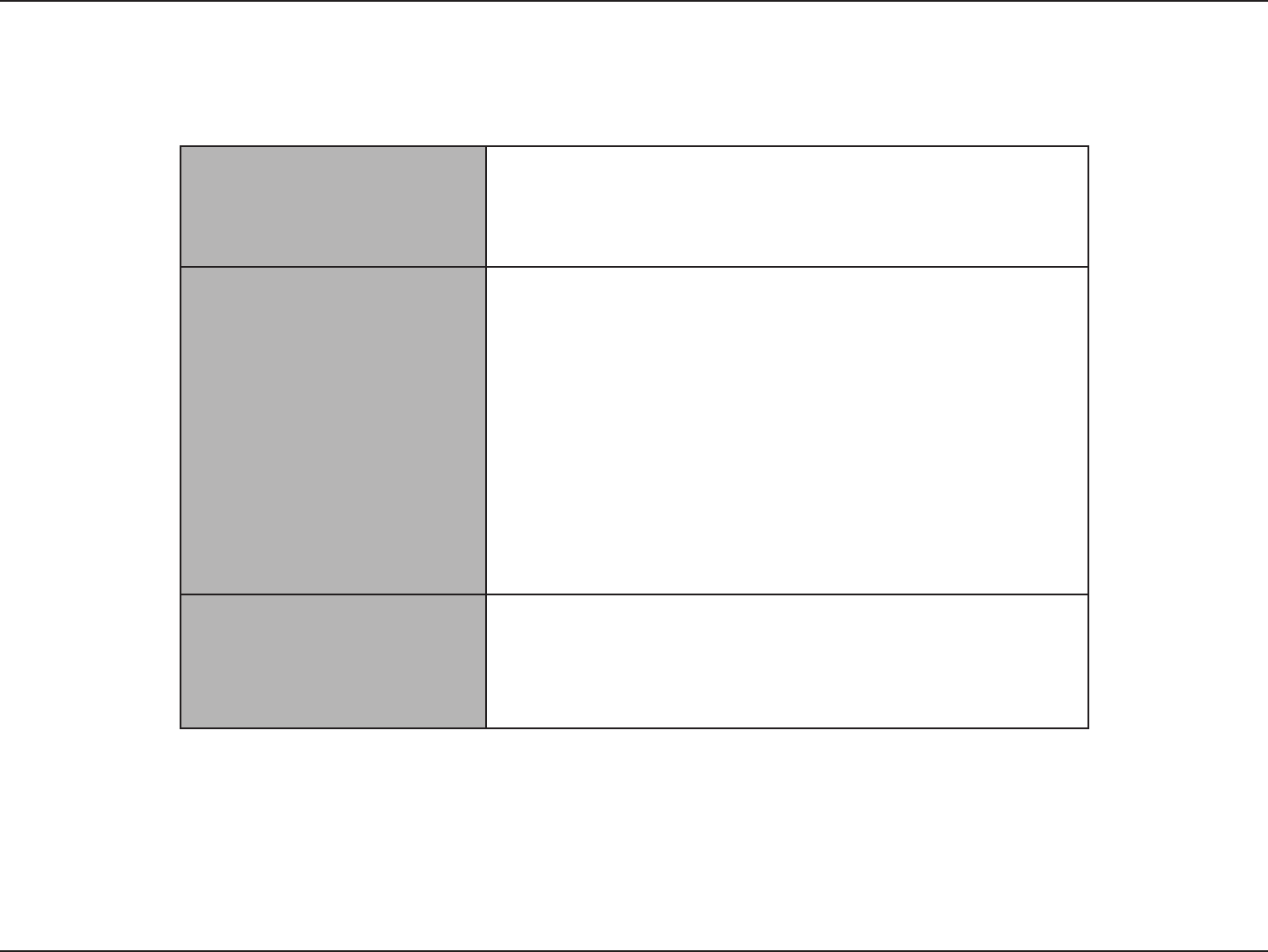
2D-Link DHP-1320 User Manual
Section 1 - Product Overview
Network Requirements
• An Ethernet-based Cable or DSL modem
• IEEE 802.11n or 802.11g wireless clients
• 10/100 Ethernet
Web-based Conguration
Utility Requirements
Computer with the following:
• Windows®, Macintosh, or Linux-based operating system
• An installed Ethernet adapter
Browser Requirements:
• Internet Explorer 6 or higher
• Firefox 3.0 or higher
• Safari 3.0 or higher
• Chrome 2.0 or higher
Windows® Users: Make sure you have the latest version of Java
installed. Visit www.java.com to download the latest version.
CD Installation Wizard
Requirements
Computer with the following:
• Windows® 7/ Vista® / XP with Service Pack 3
• An installed Ethernet adapter
• CD-ROM drive
System Requirements

3D-Link DHP-1320 User Manual
Section 1 - Product Overview
Introduction
TOTAL PERFORMANCE
Combines award winning router features and IEEE 802.11n/g wireless technology to provide the best wireless performance.
TOTAL SECURITY
The most complete set of security features including Active Firewall and WPA/WPA2 to protect your network against outside intruders.
TOTAL COVERAGE
Provides greater wireless signal rates even at farther distances for best-in-class Whole Home Coverage.
ULTIMATE PERFORMANCE
The D-Link Wireless N PowerLine Router (DHP-1320) is a 802.11n compliant device that delivers real world performance of up to 14x faster than an
802.11g wireless connection (also faster than a 100Mbps wired Ethernet connection). Create a secure wireless network to share photos, les, music,
video, printers, and network storage throughout your home. Connect the DHP-1320 router to a cable or DSL modem and share your high-speed
Internet access with everyone on the network. In addition, this Router includes a Quality of Service (QoS) engine that keeps digital phone calls
(VoIP) and online gaming smooth and responsive, providing a better Internet experience.
TOTAL NETWORK SECURITY
The Wireless N PowerLine Router supports all of the latest wireless security features to prevent unauthorized access, be it from over the wireless
network or from the Internet. Support for WPA/WPA2 standards ensure that you’ll be able to use the best possible encryption method, regardless
of your client devices. In addition, this router utilizes dual active rewalls (SPI and NAT) to prevent potential attacks from across the Internet.
* Maximum wireless signal rate derived from IEEE Standard 802.11g and 802.11n specications. Actual data throughput will vary. Network conditions and environmental factors,
including volume of network trac, building materials and construction, and network overhead, lower actual data throughput rate. Environmental conditions will adversely
aect wireless signal range.

4D-Link DHP-1320 User Manual
Section 1 - Product Overview
• Faster Wireless Networking - The DHP-1320 provides up to 300Mbps* wireless connection with other 802.11n wireless clients.
This capability allows users to participate in real-time activities online, such as video streaming, online gaming, and real-time
audio. The performance of this 802.11n wireless router gives you the freedom of wireless networking at speeds 650% faster than
802.11g.
• Compatible with 802.11g Devices - The DHP-1320 is still fully compatible with the IEEE 802.11g standards, so it can connect with
existing 802.11g PCI, USB, and Cardbus adapters.
• Advanced Firewall Features - The Web-based user interface displays a number of advanced network management features
including:
• Content Filtering - Easily applied content ltering based on MAC Address, URL, and/or Domain Name.
• Filter Scheduling - These lters can be scheduled to be active on certain days or for a duration of hours or minutes.
• Secure Multiple/Concurrent Sessions - The DHP-1320 can pass through VPN sessions. It supports multiple and
concurrent IPSec and PPTP sessions, so users behind the DHP-1320 can securely access corporate networks.
• User-friendly Setup Wizard - Through its easy-to-use Web-based user interface, the DHP-1320 lets you control what information
is accessible to those on the wireless network, whether from the Internet or from your company’s server. Congure your router to
your specic settings within minutes.
* Maximum wireless signal rate derived from IEEE Standard 802.11g, and 802.11n specications. Actual data throughput will vary. Network conditions and environmental factors,
including volume of network trac, building materials and construction, and network overhead, lower actual data throughput rate. Environmental conditions will adversely
aect wireless signal range.
Features
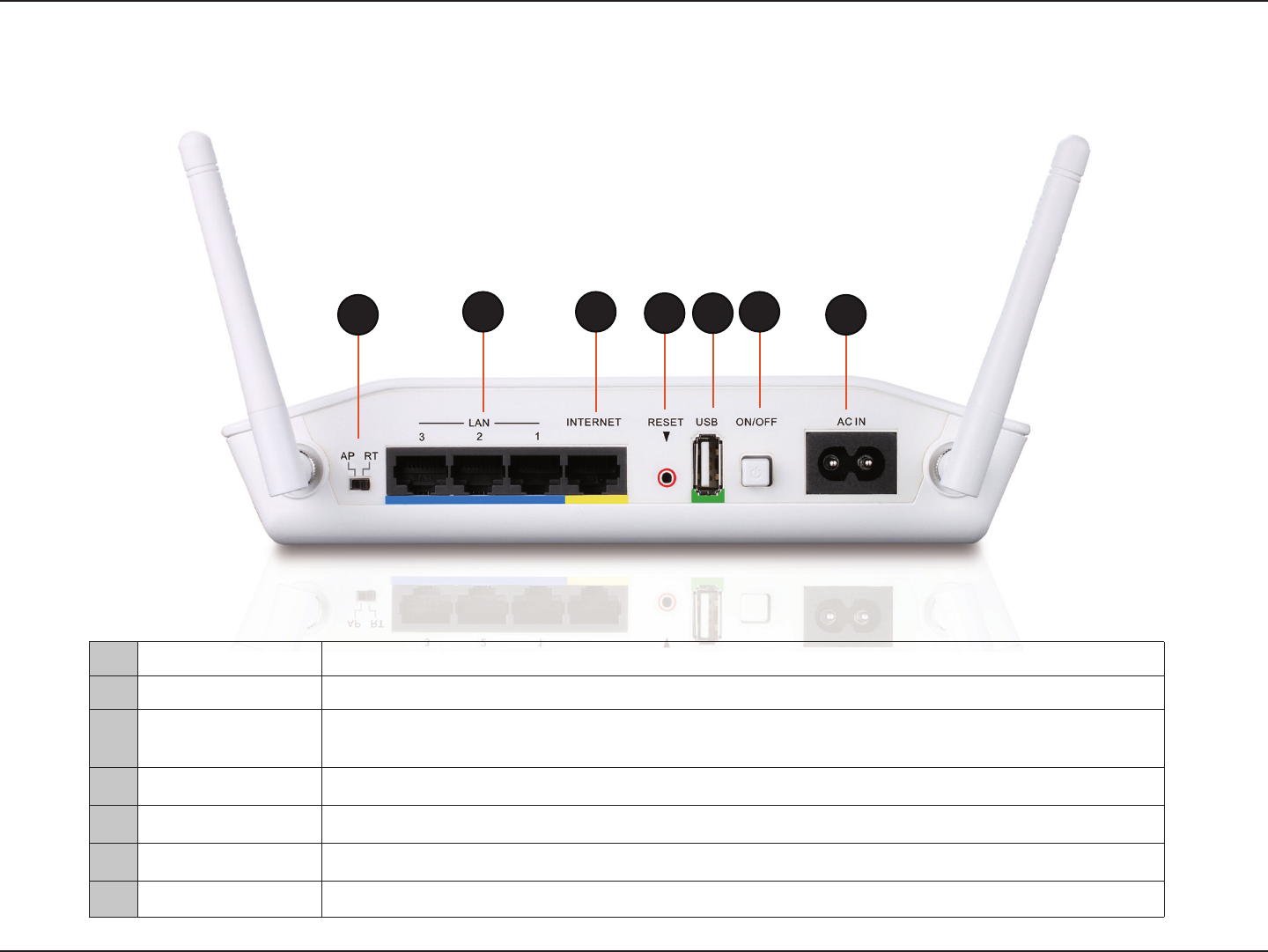
5D-Link DHP-1320 User Manual
Section 1 - Product Overview
Hardware Overview
Connections
1AP-Router Switch Two-way switch used to Select AP or Router Mode.
2LAN Ports (1-3) Connect 10/100 Ethernet devices such as computers, switches, and hubs.
3Internet Port The auto MDI/MDIX Internet port is the connection for the Ethernet cable to the cable or DSL
modem.
4Reset Button Pressing the Reset button restores the router to its original factory default settings.
5USB USB 1.1/2.0 port for SharePortTM Network and WCN support.
6Power Button Use this switch to power on/power o the device.
7Power Receptor Receptor for the supplied power cord.
2 3 456
1 7

6D-Link DHP-1320 User Manual
Section 1 - Product Overview
Hardware Overview
WPS Button
1WPS Button
Press the WPS button for one second to initiate the WPS process. The button will ash blue while
a WPS connection is being established. The button will light solid blue for 5 seconds when the
device has successfully been added to the network.
2ENY Button Push this button to establish a secure PowerLine network with other PowerLine AV devices.
12

7D-Link DHP-1320 User Manual
Section 1 - Product Overview
1Power LED A solid green light indicates a proper connection to the power supply. This LED will light orange during a factory reset or
reboot. A slow blinking orange LED indicates that the Router has crashed during bootup.
2Internet LED A solid green light indicates that the internet connection has successfully completed. This LED blinks green during data
transmission. A solid orange light indicates that the physical link is up, but the ISP service is down.
3WLAN LED A solid light indicates that the 2.4GHz wireless segment is ready. This LED blinks during wireless data transmission.
4PowerLine AV LEDs A solid light indicates that a powerLine connection is established. The LED will blink quickly when data is transmitted to or
from another PowerLine unit.
5LAN LEDs (1-3) A solid light indicates a connection to an Ethernet-enabled computer on ports 1-3. This LED blinks during data transmission.
6USB LED A solid light indicated that the USB device is ready. This LED blinks during data transmission.
Hardware Overview
LEDs
12
3456

8D-Link DHP-1320 User Manual
Section 2 - Installation
Before you Begin
Installation
This section will walk you through the installation process. Placement of the router is very important. Do not place the router in an enclosed area
such as a closet, cabinet, or in the attic or garage.
• Please congure the router with the computer that was last connected directly to your modem.
• You can only use the Ethernet port on your modem. If you were using the USB connection before using the router, then you must
turn o your modem, disconnect the USB cable and connect an Ethernet cable to the Internet port on the router, and then turn
the modem back on. In some cases, you may need to call your ISP to change connection types (USB to Ethernet).
• If you have DSL and are connecting via PPPoE, make sure you disable or uninstall any PPPoE software such as WinPoet, Broadjump,
or Enternet 300 from your computer or you will not be able to connect to the Internet.
• When running the Setup Wizard from the D-Link CD, make sure the computer you are running the CD from is connected to the
Internet and online or the wizard will not work. If you have disconnected any hardware, re-connect your computer back to the
modem and make sure you are online.

9D-Link DHP-1320 User Manual
Section 2 - Installation
Wireless Installation Considerations
The D-Link wireless router lets you access your network using a wireless connection from virtually anywhere within the operating range of your
wireless network. Keep in mind, however, that the number, thickness and location of walls, ceilings, or other objects that the wireless signals must
pass through, may limit the range. Typical ranges vary depending on the types of materials and background RF (radio frequency) noise in your
home or business. The key to maximizing wireless range is to follow these basic guidelines:
1. Keep the number of walls and ceilings between the D-Link router and other network devices to a minimum - each wall or ceiling
can reduce your adapter’s range from 3-90 feet (1-30 meters.) Position your devices so that the number of walls or ceilings is
minimized.
2. Be aware of the direct line between network devices. A wall that is 1.5 feet thick (.5 meters), at a 45-degree angle appears to be
almost 3 feet (1 meter) thick. At a 2-degree angle it looks over 42 feet (14 meters) thick! Position devices so that the signal will
travel straight through a wall or ceiling (instead of at an angle) for better reception.
3. Building Materials make a dierence. A solid metal door or aluminum studs may have a negative eect on range. Try to position
access points, wireless routers, and computers so that the signal passes through drywall or open doorways. Materials and objects
such as glass, steel, metal, walls with insulation, water (sh tanks), mirrors, le cabinets, brick, and concrete will degrade your
wireless signal.
4. Keep your product away (at least 3-6 feet or 1-2 meters) from electrical devices or appliances that generate RF noise.
5. If you are using 2.4GHz cordless phones or X-10 (wireless products such as ceiling fans, lights, and home security systems), your
wireless connection may degrade dramatically or drop completely. Make sure your 2.4GHz phone base is as far away from your
wireless devices as possible. The base transmits a signal even if the phone in not in use.
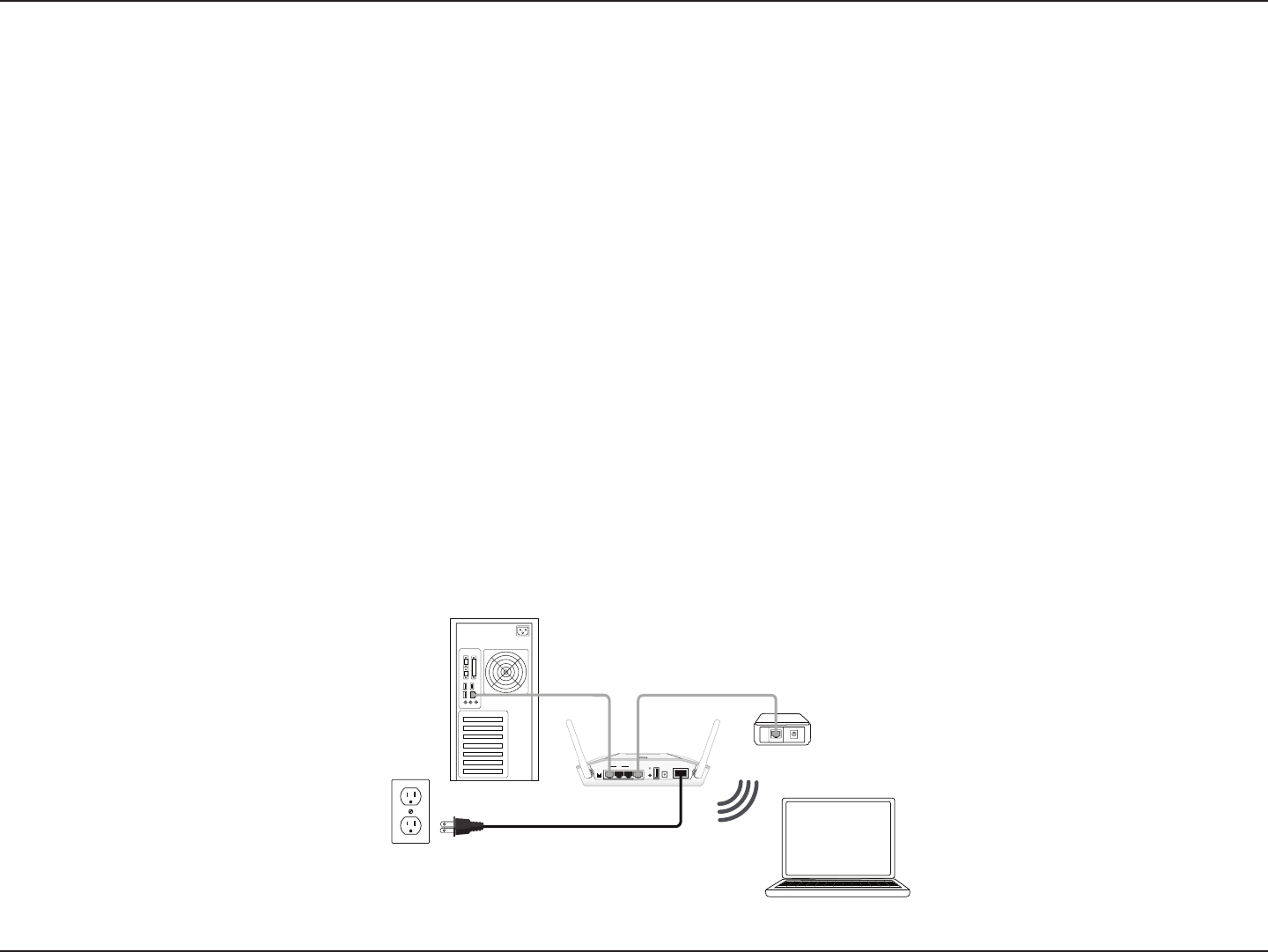
10D-Link DHP-1320 User Manual
Section 2 - Installation
Hardware Installation - For Router Mode
Network Diagram
Windows users can use the Quick Router Setup Wizard (from the CD) to congure their router. If you do not want to use the wizard, lost your CD, or are
running Mac or Linux, you will need to use the manual setup procedure below.
Start Here
Quick Router Setup Wizard
For the Wizard to work, the computer must be connected to the Internet and be online. If you have disconnected any hardware, please re-connect your
computer back into the modem and make sure you are online.
Insert the CD into your drive on a computer that is online and click Install Router to start the Quick Router Setup Wizard. Follow the onscreen instructions
to install and congure your router.
Wireless N PowerLine
Router (DHP-1320)
Modem
5V- - - 3A
1 2 LAN 3 4 INTERNET USB
RESET
INTERNET
1 2 3
INTERNETLAN
AR RT
USB
RESET ON/OFF AC IN
1 2 3
INTERNETLAN
AR RT
USB
RESET ON/OFF AC IN
INTERNET
PC

11D-Link DHP-1320 User Manual
Section 2 - Installation
If you are connecting the router to a cable/DSL/satellite modem, please follow the steps below:
1. Place the router in an open and central location. Do not plug the power adapter into the router.
2. Unplug the modem’s power adapter.
3. Unplug the Ethernet cable (that connects your computer to your modem) from your computer and place it into the Internet port
on the router.
4. Plug an Ethernet cable into one of the three LAN ports on the router. Plug the other end into the Ethernet port on your computer.
5. Plug the power adapter back to the modem. Wait for the modem to boot (about 30 seconds).
6. Plug the power cord to the router and connect to an outlet.
7. Turn on the DHP-1320 Router by pushing the power button located on the back of this unit. Then, wait about 30 seconds for the
router to boot.
8. Open a web browser, enter http://192.168.0.1 (or http://dlinkrouter) and then press Enter. When the login window appears, set
the user name to Admin and leave the password box blank. Click Log In to continue the setup and use the wizard. Please refer to
the page 22 for detailed installation information and advanced features.
Connect to Cable/DSL/Satellite Modem

12D-Link DHP-1320 User Manual
Section 2 - Installation
If you are connecting the D-Link router to another router to use as a wireless access point and/or switch, you will have to do the following before
connecting the router to your network:
• Disable UPnP™
• Disable DHCP
• Change the LAN IP address to an available address on your network. The LAN ports on the router cannot accept a DHCP address
from your other router.
To connect to another router, please follow the steps below:
1. Plug the power into the router and use the power switch to power up the router. Connect one of your computers to the router (LAN port) using
an Ethernet cable. Make sure your IP address on the computer is 192.168.0.xxx (where xxx is between 2 and 254). Please see the Networking
Basics section for more information. If you need to change the settings, write down your existing settings before making any changes. In most
cases, your computer should be set to receive an IP address automatically in which case you will not have to do anything to your computer.
2. Open a web browser and enter http://192.168.0.1 and press Enter. When the login window appears, set the user name to Admin and leave the
password box empty. Click Log In to continue.
3. Click on Advanced and then click Advanced Network. Uncheck the Enable UPnP checkbox. Click Save Settings to continue.
4. Click Setup and then click Network Settings. Uncheck the Enable DHCP Server checkbox. Click Save Settings to continue.
5. Under Router Settings, enter an available IP address and the subnet mask of your network. Click Save Settings to save your settings. Use this
new IP address to access the conguration utility of the router in the future. Close the browser and change your computer’s IP settings back to
the original values as in Step 1.
Connect to Another Router

13D-Link DHP-1320 User Manual
Section 2 - Installation
6. Disconnect the Ethernet cable from the router and reconnect your computer to your network.
7. Connect an Ethernet cable in one of the LAN ports of the router and connect it to your other router. Do not plug anything into the Internet
(WAN) port of the D-Link router.
8. You may now use the other 2 LAN ports to connect other Ethernet devices and computers. To congure your wireless network, open a web
browser and enter the IP address you assigned to the router. Refer to the Conguration and Wireless Security sections for more information
on setting up your wireless network.
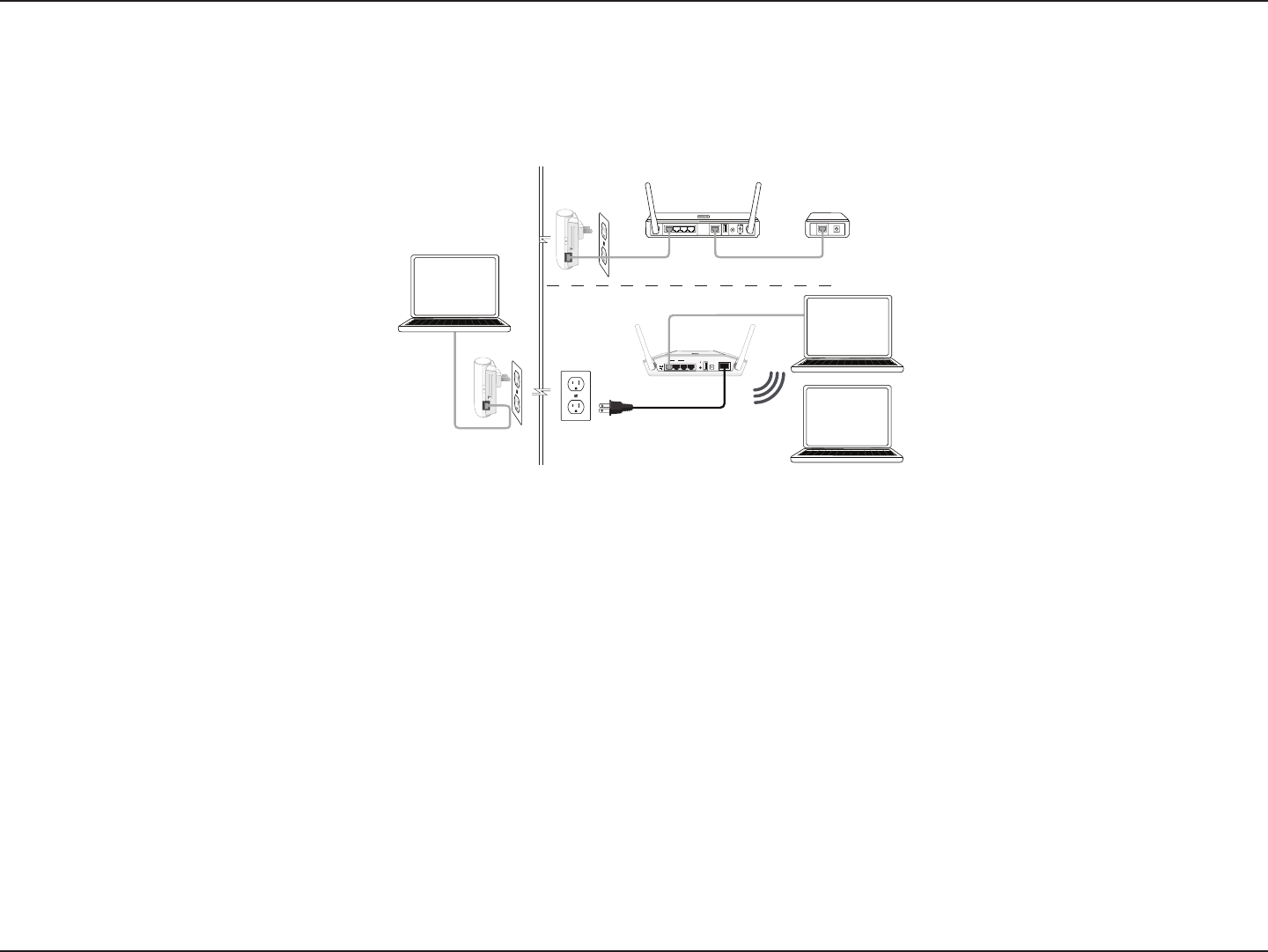
14D-Link DHP-1320 User Manual
Section 2 - Installation
Hardware Installation - For Access Point Mode
5V- - - 3A
1 2 LAN 3 4 INTERNET USB
RESET
INTERNET
1 2 3
INTERNETLAN
AR RT
USB
RESET ON/OFF AC IN
1 2 3
INTERNETLAN
AR RT
USB
RESET ON/OFF AC IN
INTERNET
DHP-306AV
Wireless Router
Modem
Wireless N
PowerLine Router
(AP Mode)
DHP-306AV
Step 2
Turn on the DHP-1320 by pushing the power button located on the back of this unit. Connect one end of the included Ethernet cable to the
Ethernet port on the DHP-1320 and attach the other end of the Ethernet cable to the PC as illustrated in Room 3.
Note: Connection to an Ethernet-enabled device is conrmed when the green LED Ethernet indicator on the PowerLine device is illuminated.
Step 3
Open a web browser, enter http://192.168.0.1 and press Enter. When the login window appears, set the user name to Admin and leave the password
box blank. Click Log In to continue the setup. Please refer to the user to page 108 for more detailed installation information and advanced features.
Step 1
Move the switch on the back of the DHP-1320 to “AP”. Connect the supplied power cord into the power receptor located on the back of the DHP-
1320 and plug into a power outlet as illustrated in Room 3.
Note: To secure the PowerLine Network from unauthorize users, please refer to the PowerLine Network Security section.
Note: Power source is conrmed when the green LED Power Indicator on the PowerLine devices is illuminated.
Room 2 Room 1
Room3

15D-Link DHP-1320 User Manual
Section 1 - Product Overview
PowerLine Installation Considerations
Plan the location of your PowerLine devices:
1. Connect the PowerLine devices to electrial outlets that are not controlled by a wall switch in order to avoid accidentally turning o the power
to the device.
2. Do not connect the Wireless N PowerLine Router to an extension cord, surge protector, or power strip. This might prevent the device from
working correctly or it may reduce the network performance.
3. Avoid using the Wireless N PowerLine Router in an electrical outlet that is located near an appliance that uses a lot of power, such as a washer,
dryer or refrigerator. This may prevent the adapter from working correctly, or may negatively impact the network perfomance.
4. Verify that your PowerLine devices are electrically rated to operate with the power available in your location.
5. To help prevent against electrical shock, be sure to plug the power cables into properly grounded electrical outlets.

16D-Link DHP-1320 User Manual
Section 1 - Product Overview
PowerLine Security
It is strongly recommended to encrypt your PowerLine network. By encrypting the data that is sent via your PowerLine adapters, you will prevent
nearby hackers with a Powerline adapter to connect to your network and steal your information.
To encrypt your PowerLine network, follow the steps below:
PowerLine Network-Quick Setup
The ENY Button is used to add a PowerLine AV device to a PowerLine network. You can allow the DHP-1320 to join a network by pressing the ENY
Button to toggle it to the Broadcast state or Join state.
The ENY Button has 3 dierent trigger states:
Broadcast state- Enables the DHP-1320 to provide information for another PowerLine AV device to join its PowerLine network (works
even if it is the only device existing within the network group). The rst PowerLine device will use this state when the ENY Button is
pressed.
Join State - This allows an ungrouped PowerLine AV device to join an existing PowerLine network. PowerLine devices added after
the rst device will be in the Join State when the ENY Button is pressed.
Ungroup State - Hold down the ENY Button for more than 10 seconds to detach the device from its network group.
Encryption Button Usage

17D-Link DHP-1320 User Manual
Section 1 - Product Overview
Conguring a PowerLine Network
Connecting two PowerLine AV devices for the rst time
To initially connect the DHP-1320 AV to another PowerLine AV device and create a network:
1. Plug the DHP-1320 into a power outlet. Press the ENY button for 1 to 3 seconds. The PowerLine AV LED should start to blink.
2. Plug the other PowerLine device (e.g. the DHP-W306AV) into a power outlet. Press the ENY button on this PowerLine device for 1 to 3 seconds.
3. Wait for both devices to reboot (all LEDs will turn o and on). When the PowerLine AV LEDs on both devices are steadily lit, the two devices will
be networked together.
INTERNET
1 2 3
INTERNETLAN
AR RT
USB
RESET ON/OFF AC IN
INTERNET
1 2 3
INTERNETLAN
AR RT
USB
RESET ON/OFF AC IN
Room B
Room A
Room C
DHP-W306AV
DHP-W306AV
DHP-1320

18D-Link DHP-1320 User Manual
Section 1 - Product Overview
Connecting a PowerLine AV device to an existing PowerLine network
To add a DHP-1320 if you already have an existing network with 2 more PowerLine devices:
1. Press the ENY button on the DHP-1320 for more than 10 seconds to make sure it is not connected to any other PowerLine network.
2. Press the ENY button of any device already in your PowerLine network (e.g. the DHP-306AV) for 1 to 3 seconds. The ENY LED should start to blink.
3. Press the ENY button on the DHP-1320 for 1 to 3 seconds. The PowerLine AV LED should start to blink.
4. Wait for the DHP-1320 to reboot (all LEDs will tun o and on). When the PowerLine AV LED on all devices are steadily lit, the DHP-1320 will
be connected to the existing network.
Room B
Room A
Room C
DHP-W306AV
DHP-1320
DHP-306AV
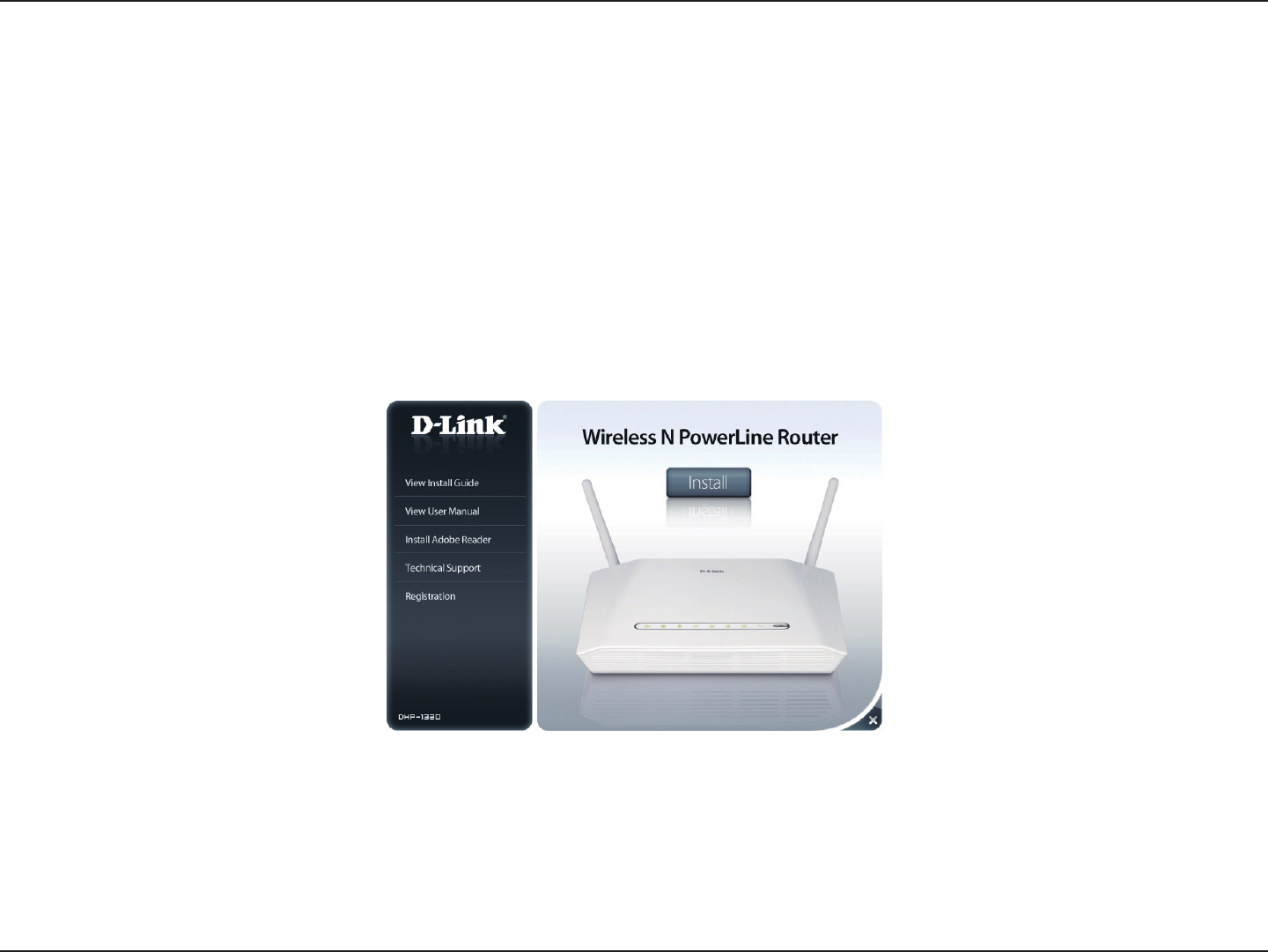
19D-Link DHP-1320 User Manual
Section 2 - Installation
The DHP-1320 includes a Quick Router Setup Wizard CD. Follow the simple steps below to run the Setup Wizard to guide you
quickly through the installation process.
Insert the Quick Router Setup Wizard CD in the CD-ROM drive. The step-by-step instructions that follow are shown in Windows® XP. The steps
and screens are similar for the other Windows operating systems.
If the CD Autorun function does not automatically start on your computer, go to Start > Run. In the run box type“D:\autorun.exe” (where D:
represents the drive letter of your CD-ROM drive).
When the autorun screen appears, click Install.
Getting Started
Note: It is recommended to write down the SSID and Security Key, followed by the login password on the provided CD holder.
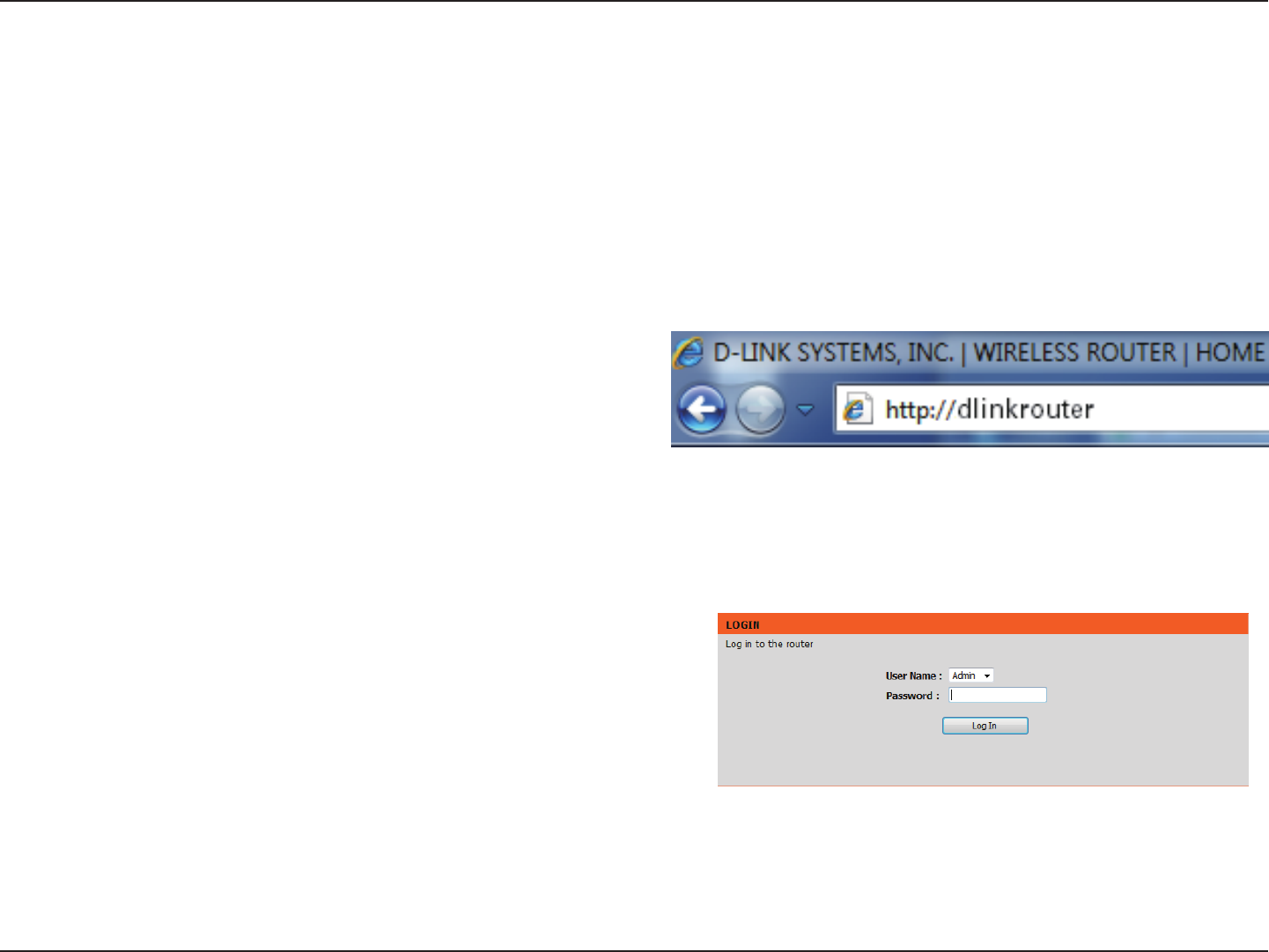
20D-Link DHP-1320 User Manual
Section 3 - Conguration
Conguration (Router Mode)
This section will show you how to congure your new D-Link wireless router using the web-based conguration utility.
Web-based Conguration Utility
To access the conguration utility, open a web-browser such as Internet
Explorer and enter the IP address of the router (192.168.0.1).
Select Admin in the User Name eld. Leave the password blank by default.
If you get a Page Cannot be Displayed error, please refer to the
Troubleshooting section for assistance.

21D-Link DHP-1320 User Manual
Section 3 - Conguration
Internet
Setup
This section allows you to congure your Router’s Internet settings.
The Internet Connection Setup Wizard provides a quick
method for conguring your Internet settings. To start
the Internet Connection Setup Wizard, click the Internet
Connection Setup Wizard button. Refer to “Internet
Connection Setup Wizard” on page 22 for more information
on how to use the Internet Connection Setup Wizard.
Click the Manual Internet Connection Setup button if
you want to enter your Internet settings without running
the Internet Connection Setup Wizard. Refer to “Manual
Internet Connection Setup” on page 28 for more information
on how to congure your Internet settings manually.
Internet
Connection
Setup Wizard:
Manual Internet
Connection
Option:
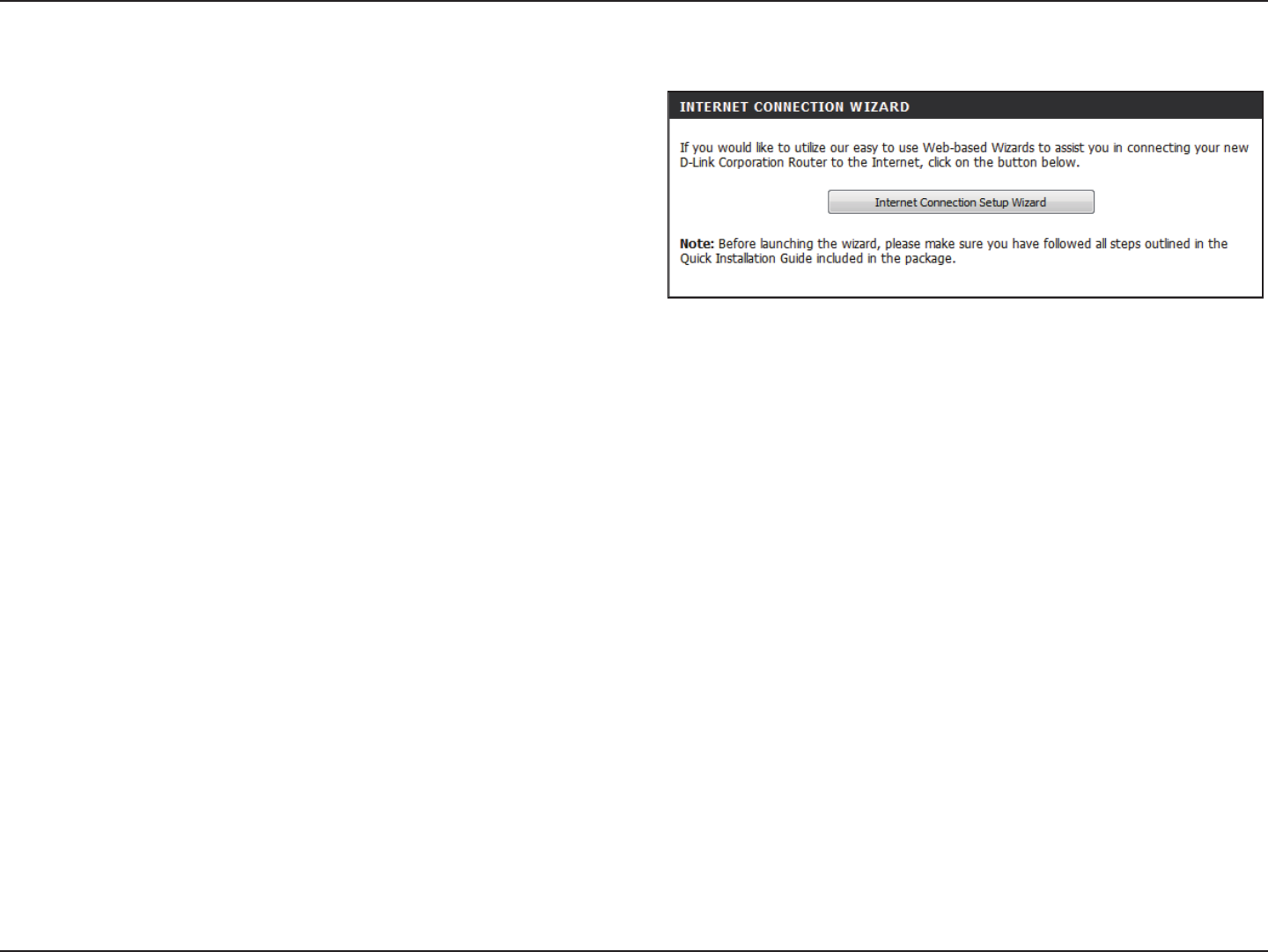
22D-Link DHP-1320 User Manual
Section 3 - Conguration
Internet Connection Setup Wizard
Click the Internet Connection Setup Wizard button to start the Internet
Connection Setup Wizard.
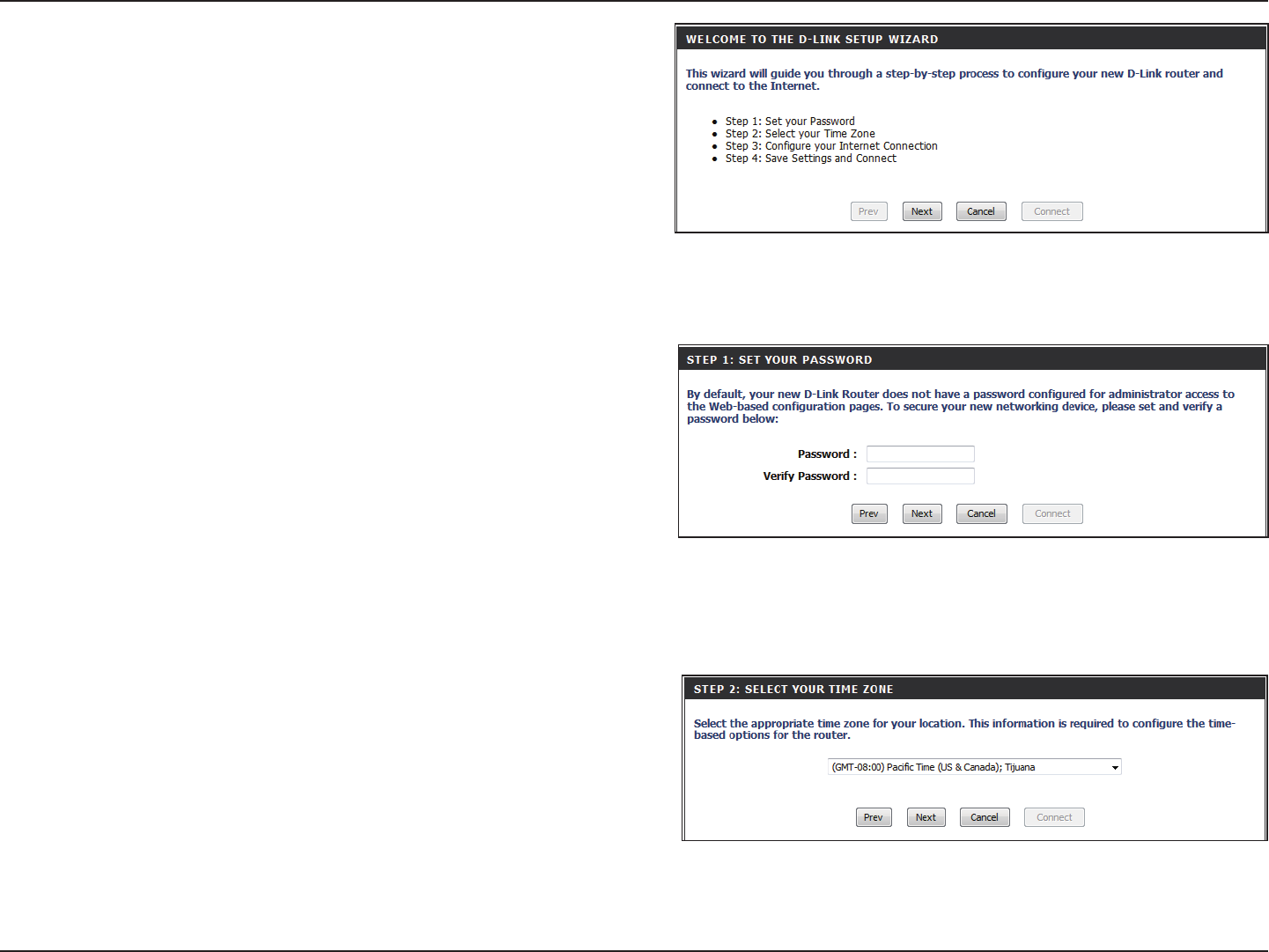
23D-Link DHP-1320 User Manual
Section 3 - Conguration
Create a new password and then click Next to continue.
The following window appears, summarizing the steps required to
complete the Internet Connection Setup Wizard:
Click Next to continue.
Select your time zone from the drop-down menu and then click Next to
continue.
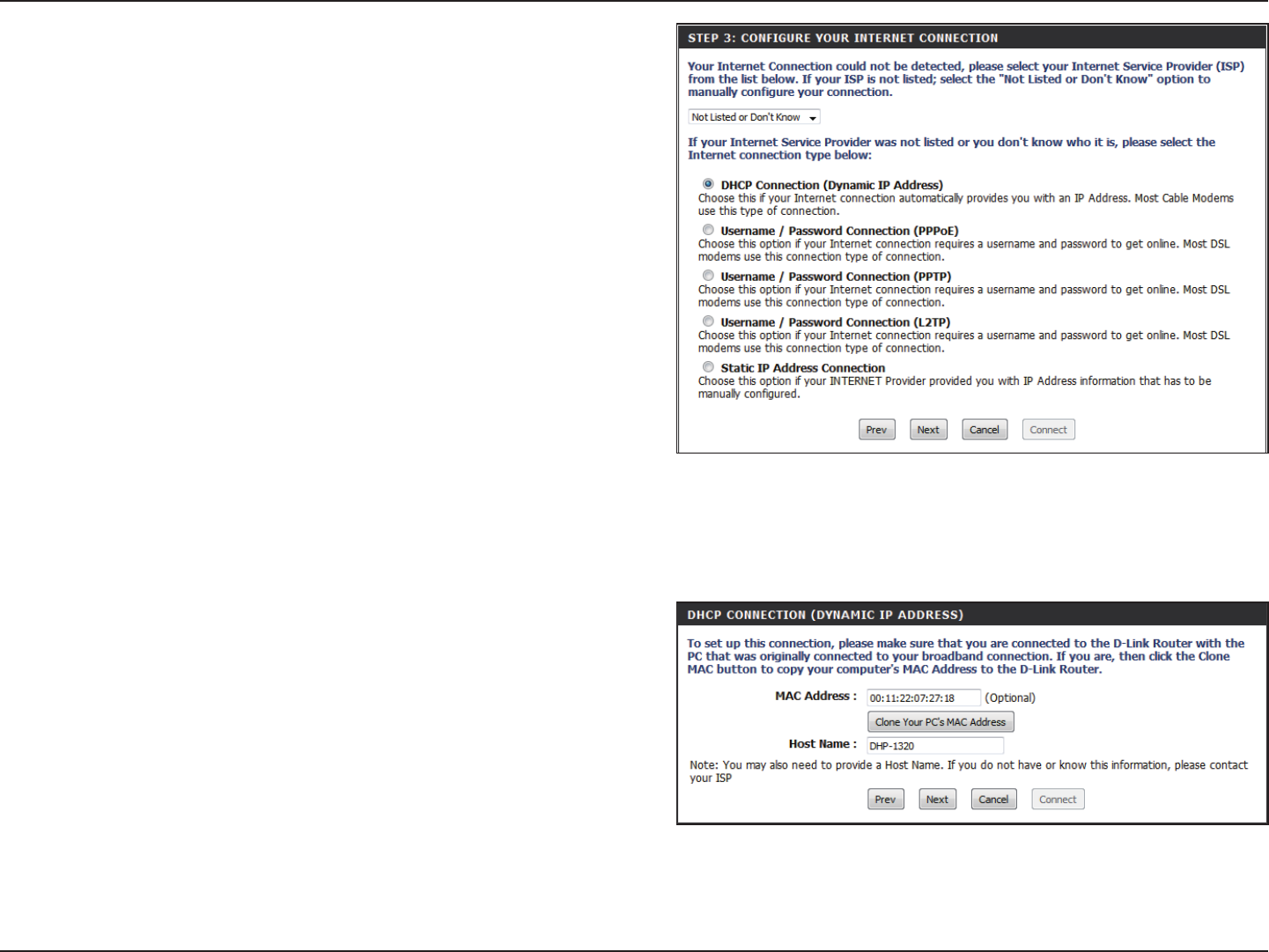
24D-Link DHP-1320 User Manual
Section 3 - Conguration
Select the type of Internet connection you use and then click Next to
continue.
If you selected DHCP Connection (Dynamic IP Address), you may need to
enter the MAC address of the computer that was last connected directly
to your modem. If you are currently using that computer, click Clone Your
PC’s MAC Address and then click Next to continue.
The Host Name is optional but may be required by some ISPs. The default
host name is the device name of the router and may be changed.
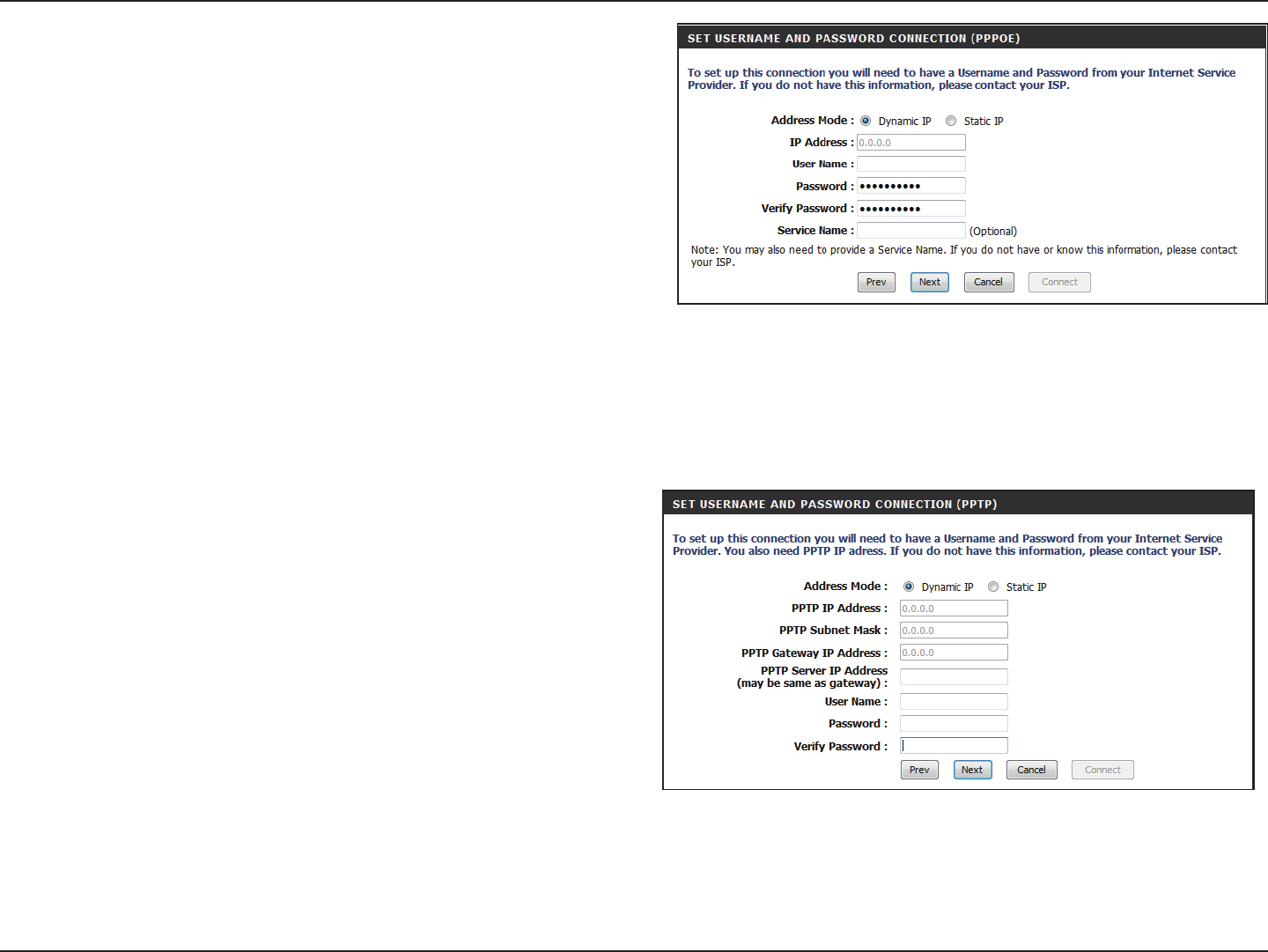
25D-Link DHP-1320 User Manual
Section 3 - Conguration
If you selected PPPoE, enter your PPPoE username and password.
If your ISP requires you to enter a PPPoE service name, enter the service
name in the Service Name eld.
Select Static if your ISP assigned you the IP address, subnet mask, gateway,
and DNS server addresses.
Click Next to continue.
Note: Make sure to remove your PPPoE software from your computer. The
software is no longer needed and will not work through a router.
If you selected PPTP, enter your PPTP username and password.
Select Static if your ISP assigned you the IP address, subnet mask, gateway,
and PPTP server addresses.
Click Next to continue.
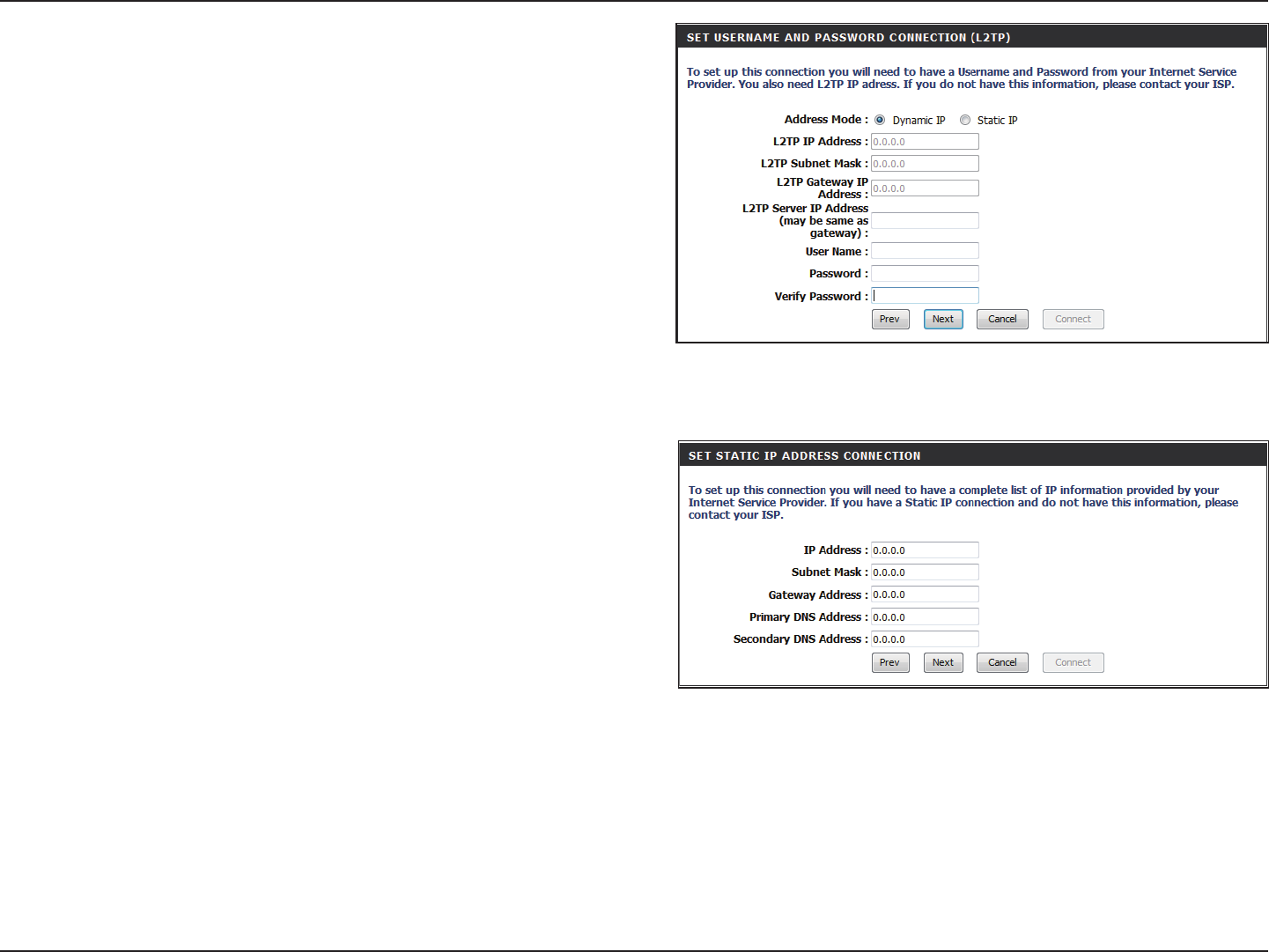
26D-Link DHP-1320 User Manual
Section 3 - Conguration
If you selected L2TP, enter your L2TP username and password.
Select Static if your ISP assigned you the IP address, subnet mask, gateway,
and L2TP server addresses.
Click Next to continue.
If you selected Static, enter your network settings supplied by your Internet
provider.
Click Next to continue.

27D-Link DHP-1320 User Manual
Section 3 - Conguration
Click Connect to save your settings.
The following window appears to indicate that the settings are being
saved. When the Router has nished saving all the changes, the Setup>
Internet window will open.
Close your browser window and reopen it to test your Internet connection.
It may take a few tries to initially connect to the Internet.

28D-Link DHP-1320 User Manual
Section 3 - Conguration
Manual Internet Connection Setup
Use the My Internet Connection is drop-down menu to
select the mode that the router should use to connect to
the Internet.
Advanced Domain Name System (DNS) Services enhances
your Internet performance by getting you the information
and web pages you are looking for faster and more reliably.
In addition, it improves your overall Internet experience
by correcting many common typo mistakes automatically,
taking you where you intended to go and saving you
valuable time.
Disclaimer: D-Link makes no warranty as to the availability,
reliability, fuctionality and operation of the Advanced DNS
service or its features.
Internet
Connection
Type:
Advanced
DNS Service:
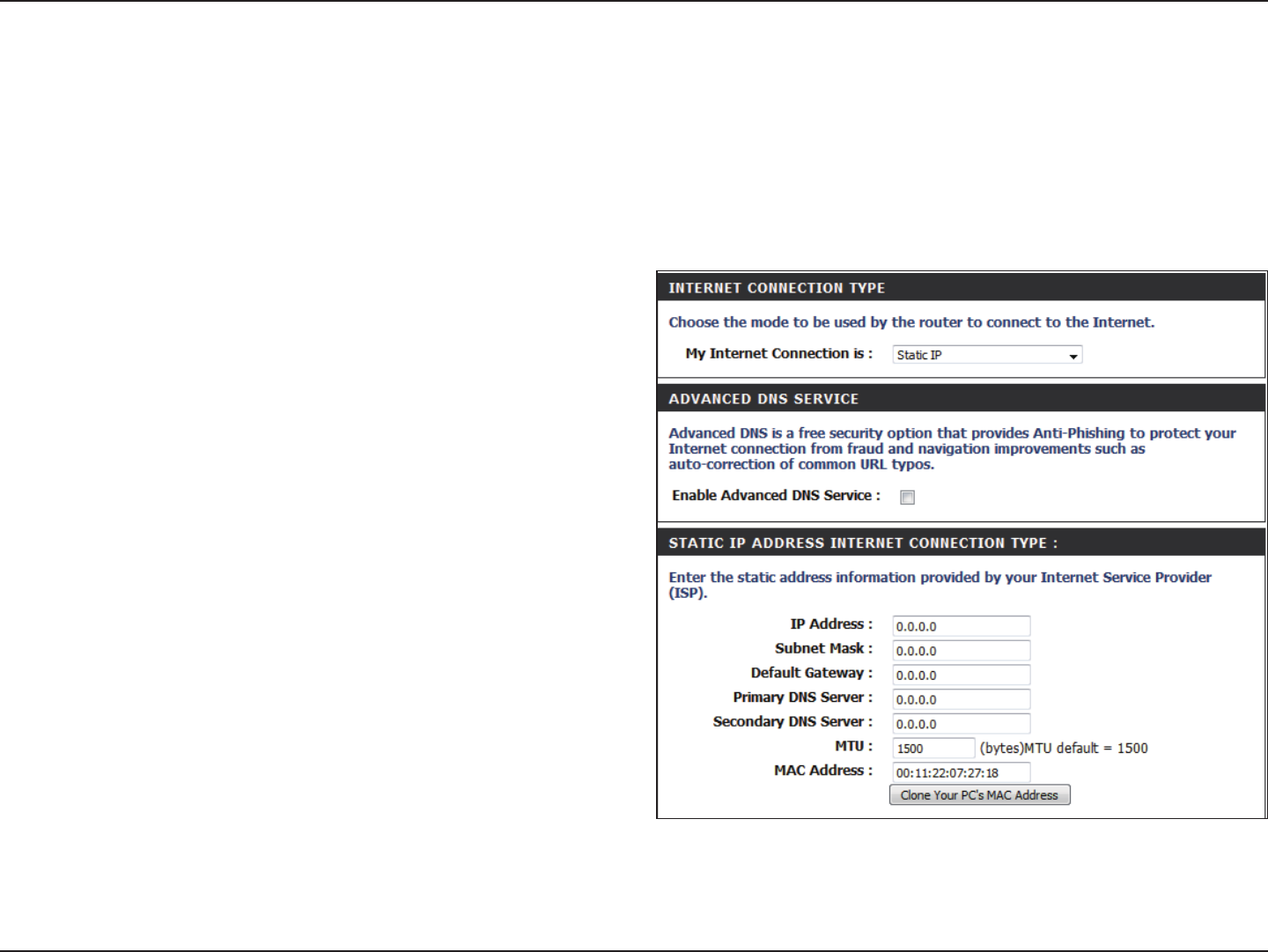
29D-Link DHP-1320 User Manual
Section 3 - Conguration
Enter the IP address assigned by your ISP.
Enter the Subnet Mask assigned by your ISP.
Enter the Gateway assigned by your ISP.
The DNS server information will be supplied by your ISP
(Internet Service Provider).
Maximum Transmission Unit - you may need to change the
MTU for optimal performance with your specic ISP. 1500
is the default MTU.
The default MAC Address is set to the Internet port’s
physical interface MAC address on the Broadband Router.
It is not recommended that you change the default MAC
address unless required by your ISP. You can use the Clone
Your PC’s MAC Address button to replace the Internet port’s
MAC address with the MAC address of your Ethernet card.
IP Address:
Subnet Mask:
Default Gateway:
DNS Servers:
MTU:
MAC Address:
Manual Internet Connection Setup
Static IP
Select Static IP from the drop-down menu if all the Internet port’s IP information is provided to you by your ISP. You will need
to enter in the IP address, subnet mask, gateway address, and DNS address(es) provided to you by your ISP. Each IP address
entered in the elds must be in the appropriate IP form, which are four octets separated by a dot (x.x.x.x). The Router will not
accept the IP address if it is not in this format.
Click the Save Settings button to save any changes made.
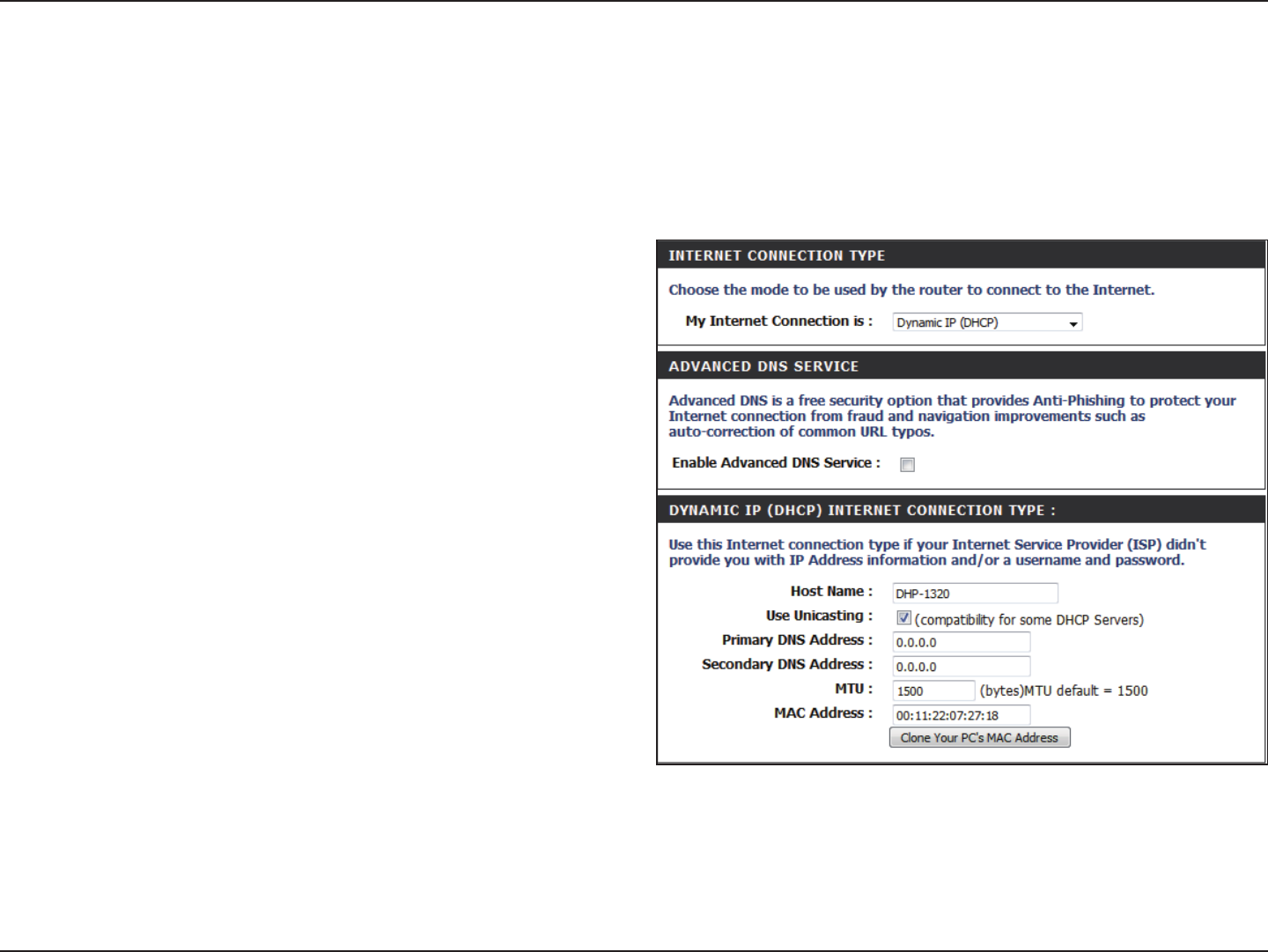
30D-Link DHP-1320 User Manual
Section 3 - Conguration
The Host Name is optional but may be required by some
ISPs. Leave blank if you are not sure.
Enter the Primary and Secondary DNS server IP addresses
assigned by your ISP. These addresses are usually obtained
automatically from your ISP. Enter the value 0.0.0.0 if you
did not specically receive these from your ISP.
Maximum Transmission Unit - you may need to change the
MTU for optimal performance with your specic ISP. 1500
is the default MTU.
The default MAC Address is set to the Internet port’s physical
interface MAC address on the Broadband Router. It is not
recommended that you change the default MAC address
unless required by your ISP. You can use the Clone Your
PC’s MAC Address button to replace the Internet port’s
MAC address with the MAC address of your Ethernet card.
Manual Internet Connection Setup
Dynamic IP (DHCP)
Select Dynamic IP (DHCP) from the drop-down menu to obtain IP Address information automatically from your ISP. Select
this option if your ISP does not give you any IP numbers to use. This option is commonly used for cable modem services such
as Comcast and Cox.
Host Name:
Primary/
Secondary DNS
Server:
MTU:
MAC Address:
Click the Save Settings button to save any changes made.

31D-Link DHP-1320 User Manual
Section 3 - Conguration
Select Static IP if your ISP assigned you the IP address,
subnet mask, gateway, and DNS server addresses. In most
cases, select Dynamic.
Enter the IP address (Static PPPoE only).
Enter your PPPoE user name.
Enter your PPPoE password and then retype the password
in the next box.
Enter the ISP Service Name (optional).
Use the radio buttons to specify the reconnect mode.
The user can specify a custom schedule or specify the On
Demand, or Manual option.
Enter a maximum idle time during which the Internet
connection is maintained during inactivity. To disable this feature, enable Auto-reconnect.
Enter the Primary and Secondary DNS Server Addresses (Static PPPoE only).
Maximum Transmission Unit - you may need to change the MTU for optimal performance with your specic ISP. 1492 is the default
MTU.
Address Mode:
IP Address:
User Name:
Password:
Service Name:
Reconnect
Mode:
Maximum Idle
Time:
DNS Servers:
MTU:
Manual Internet Connection Setup
PPPoE (Username/Password)
Select PPPoE (Username/Password) from the drop-down menu if your ISP uses a PPPoE connection. Your ISP will provide you
with a username and password. This option is typically used for DSL services. Make sure to remove your PPPoE software from
your computer. The software is no longer needed and will not work through a router.

32D-Link DHP-1320 User Manual
Section 3 - Conguration
The default MAC Address is set to the Internet port’s physical interface MAC address on the Broadband Router. It is not recommended
that you change the default MAC address unless required by your ISP. You can use the Clone Your PC’s MAC Address button to
replace the Internet port’s MAC address with the MAC address of your Ethernet card.
MAC Address:
Click the Save Settings button to save any changes made.

33D-Link DHP-1320 User Manual
Section 3 - Conguration
Select Static IP if your ISP assigned you the IP address, subnet
mask, gateway, and DNS server addresses. In most cases, select
Dynamic IP.
Enter the IP address (Static PPTP only).
Enter the Primary and Secondary DNS Server Addresses (Static
PPTP only).
Enter the Gateway IP Address provided by your ISP.
Enter the Server IP provided by your ISP (optional).
Enter your PPTP username.
Enter your PPTP password and then retype the password in the
next box.
Use the radio buttons to specify the reconnect mode. The user can
specify a custom schedule or specify the On Demand, or Manual
option.
Enter a maximum idle time during which the Internet connection
is maintained during inactivity. To disable this feature, enable
Auto-reconnect.
The DNS server information will be supplied by your ISP (Internet Service Provider).
Address Mode:
PPTP IP Address:
PPTP Subnet
Mask:
PPTP Gateway IP
Address:
PPTP Server IP
Address:
Manual Internet Connection Setup
PPTP
Username:
Password:
Reconnect
Mode:
Maximum Idle
Time:
DNS Servers:
Select PPTP (Point-to-Point Tunneling Protocol) from the drop-down menu if your ISP uses a PPTP connection. Your ISP will
provide you with a username and password. This option is typically used for DSL services.

34D-Link DHP-1320 User Manual
Section 3 - Conguration
Maximum Transmission Unit - you may need to change the MTU for optimal performance with your specic ISP. 1454 is the default
MTU.
The default MAC Address is set to the Internet port’s physical interface MAC address on the Broadband Router. It is not recommended
that you change the default MAC address unless required by your ISP. You can use the Clone Your PC’s MAC Address button to
replace the Internet port’s MAC address with the MAC address of your Ethernet card.
MTU:
MAC Address:
Click the Save Settings button to save any changes made.

35D-Link DHP-1320 User Manual
Section 3 - Conguration
Select Static if your ISP assigned you the IP address, subnet
mask, gateway, and DNS server addresses. In most cases, select
Dynamic.
Enter the L2TP IP address supplied by your ISP (Static only).
Enter the Subnet Mask supplied by your ISP (Static only).
Enter the Gateway IP Address provided by your ISP.
Enter the Server IP provided by your ISP (optional).
Enter your L2TP username.
Enter your L2TP password and then retype the password in
the next box.
Use the radio buttons to specify the reconnect mode. The user can specify a custom schedule or specify the On Demand, or Manual
option.
Enter a maximum idle time during which the Internet connection is maintained during inactivity. To disable this feature, enable
Auto-reconnect.
Enter the Primary DNS server IP address assigned by your ISP. These address is usually obtained automatically from your ISP. Enter
the value 0.0.0.0 if you did not specically receive these from your ISP.
Address Mode:
L2TP IP Address:
L2TP Subnet
Mask:
Manual Internet Connection Setup
L2TP
Choose L2TP (Layer 2 Tunneling Protocol) if your ISP uses a L2TP connection. Your ISP will provide you with a username and password. This option
is typically used for DSL services.
L2TP Gateway IP
Address:
L2TP Server IP
Address:
Username:
Password:
Reconnect
Mode:
Maximum Idle
Time:
Primary DNS
Server:

36D-Link DHP-1320 User Manual
Section 3 - Conguration
MTU:
MAC Address:
Maximum Transmission Unit - you may need to change the MTU for optimal performance with your specic ISP. 1454 is the default
MTU.
The default MAC Address is set to the Internet port’s physical interface MAC address on the Broadband Router. It is not recommended
that you change the default MAC address unless required by your ISP. You can use the Clone Your PC’s MAC Address button to
replace the Internet port’s MAC address with the MAC address of your Ethernet card.
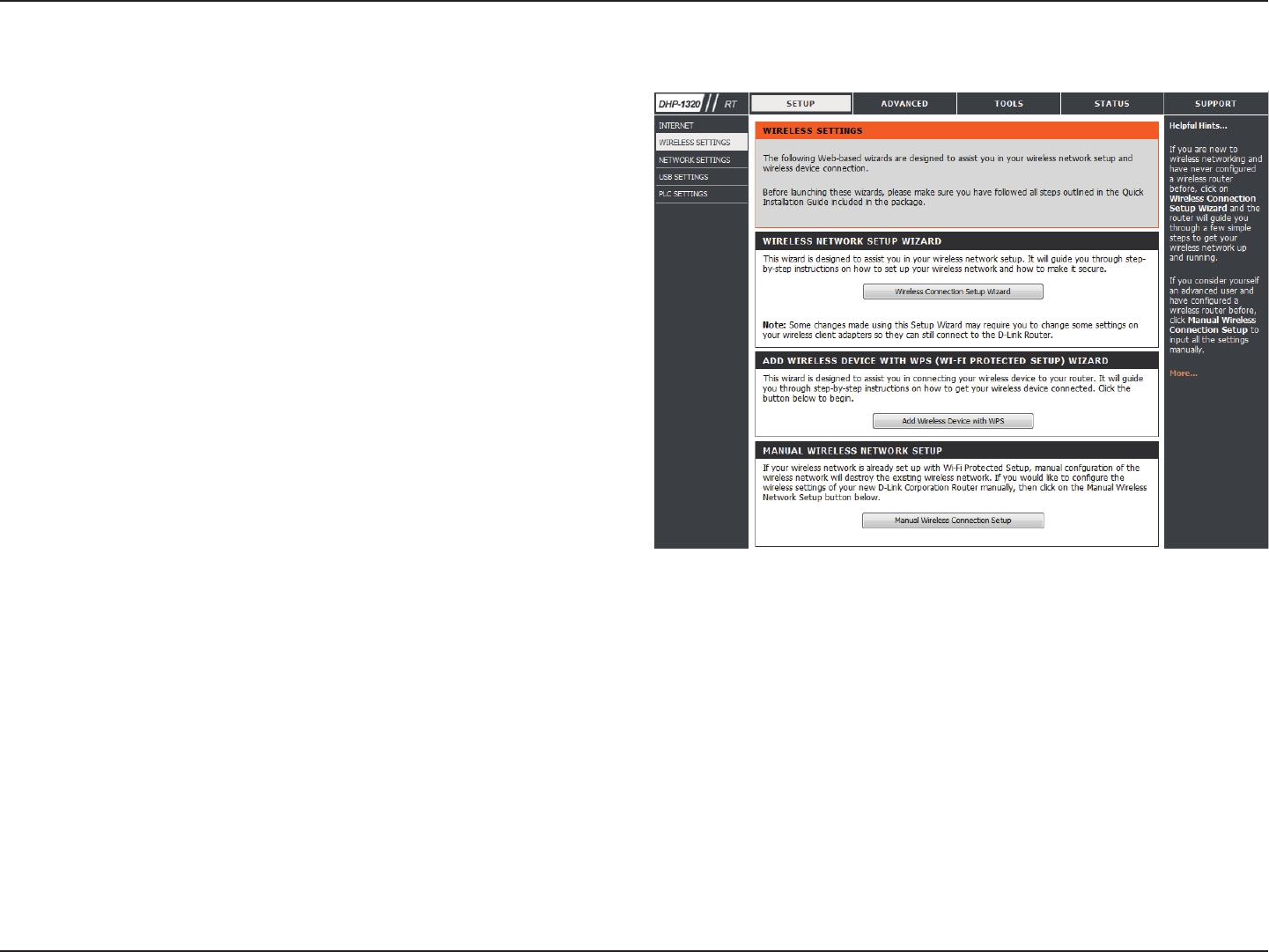
37D-Link DHP-1320 User Manual
Section 3 - Conguration
Wireless Settings
If you want to congure the wireless settings on your router using the
wizard, click Wireless Connection Setup Wizard and refer to “Wireless
Connection Setup Wizard” on page 103.
Click Add Wireless Device with WPS if you want to add a wireless device
using Wi-Fi Protected Setup (WPS) and refer to “Add Wireless Device with
WPS Wizard” on page 106.
If you want to manually congure the wireless settings on your router click
Manual Wireless Connection Setup and refer to the next page.
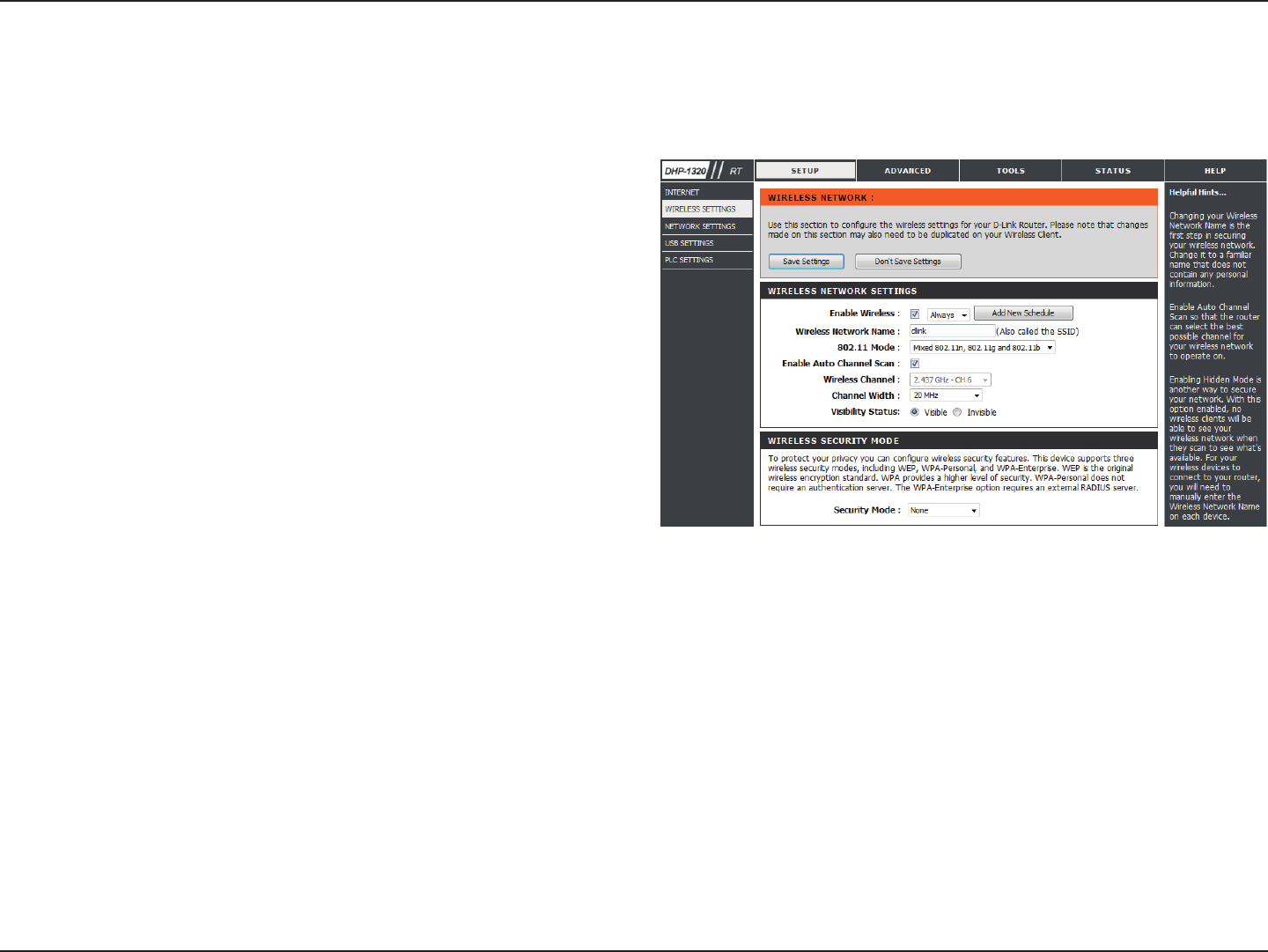
38D-Link DHP-1320 User Manual
Section 3 - Conguration
Check the box to enable the wireless function. If you do not want to use wireless, uncheck the box to disable all the wireless functions.
Select the time frame that you would like your wireless
network enabled. The schedule may be set to Always. Any
schedule you create will be available in the drop-down
menu. Click New Schedule to create a new schedule.
The Service Set Identier (SSID) is the name of your wireless
network. Create a name using up to 32 characters. The
SSID is case-sensitive.
Select one of the following:
802.11g Only - Select if all of your wireless clients are
802.11g.
802.11n Only - Select only if all of your wireless clients are
802.11n.
802.11b Only - Select if all of your wireless clients are
802.11b.
Mixed 802.11n and 802.11g - Select if you are using a mix
of 802.11n and 802.11g wireless clients.
Mixed 802.11g and 802.11b - Select if you are using a mix of 802.11g and 802.11b wireless clients.
Mixed 802.11n, 802.11g and 802.11b - Select 802.11n, 802.11g and 802.11b
The Auto Channel Selection setting can be selected to allow the DHP-1320 to choose the channel with the least amount of
interference.
Indicates the channel setting for the DHP-1320. By default the channel is set to 1. The Channel can be changed to t the channel
setting for an existing wireless network or to customize the wireless network. If you enable Auto Channel Selection, this option
will be greyed out.
Enable Wireless:
Schedule:
Wireless Network
Name:
802.11 Mode:
Enable Auto
Channel Selection:
Wireless Channel:
Manual Wireless Settings
802.11n/b/g (2.4GHz)

39D-Link DHP-1320 User Manual
Section 3 - Conguration
Channel Width:
Wireless Security
Mode:
Click the Save Settings button to save any changes made.
Select the Channel Width:
Auto 20/40 - Select if you are using both 802.11n and non-802.11n wireless devices.
20MHz - Select if you are not using any 802.11n wireless clients. This is the default setting.
Refer to “Wireless Security” on page 136 for more information regarding wireless security.
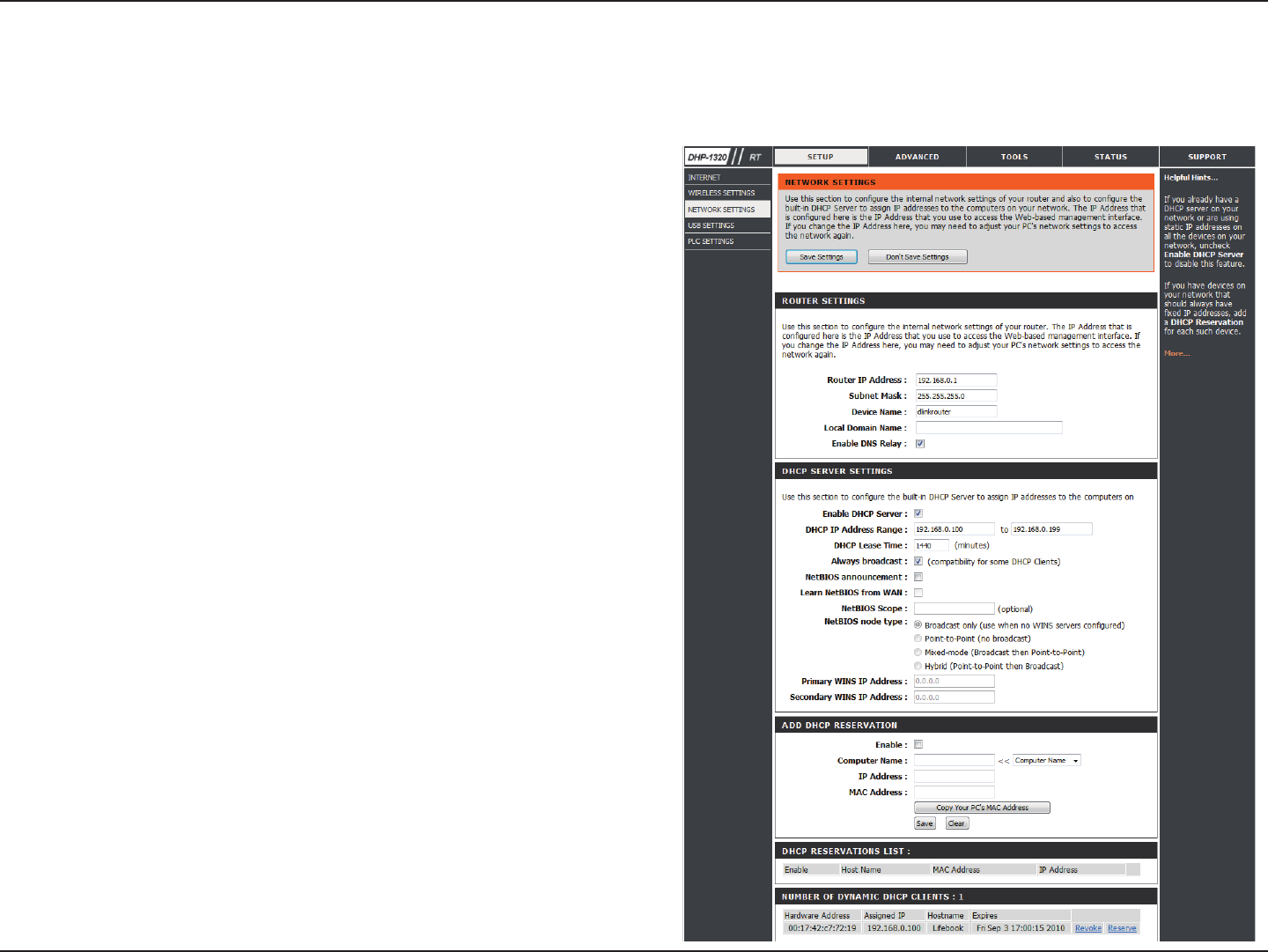
40D-Link DHP-1320 User Manual
Section 3 - Conguration
This section will allow you to change the local network settings of the router and to congure the DHCP settings.
Network Settings
Use this section to congure the Router’s local network
settings.
Use this section to congure the DHP-1320’s built-in DHCP
server settings.
Use this section to create a new DHCP reservation or
manage existing DHCP reservations.
Displays information about the devices that have a DHCP
reservation from the DHP-1320. The information includes
the Host Name, IP Address, MAC Address, and Expiration
Time.
Displays information about the devices that have a
dynamic DHCP lease from the DHP-1320. The information
includes the Host Name, IP Address, MAC Address, and Lease
Expiration Time.
Router
Settings:
DHCP Server
Settings:
Add DHCP
Reservation:
DHCP
Reservations
List:
Number of
Dynamic
DHCP Clients:

41D-Link DHP-1320 User Manual
Section 3 - Conguration
Network Settings
Enter the IP address of the router. The default IP address
is 192.168.0.1.
If you change the IP address, once you click Apply, you
will need to enter the new IP address in your browser to
get back into the conguration utility.
Enter the Subnet Mask. The default subnet mask is
255.255.255.0.
Enter a Host Name to identify the DHP-1320.
Enter the Domain name (Optional).
Uncheck the box to transfer the DNS server information
from your ISP to your computers. If checked, your
computers will use the router for a DNS server.
Router IP Address:
Default Subnet
Mask:
Device Name:
Local Domain:
Enable DNS Relay:
Router Settings
Click the Save Settings button to save any changes made.
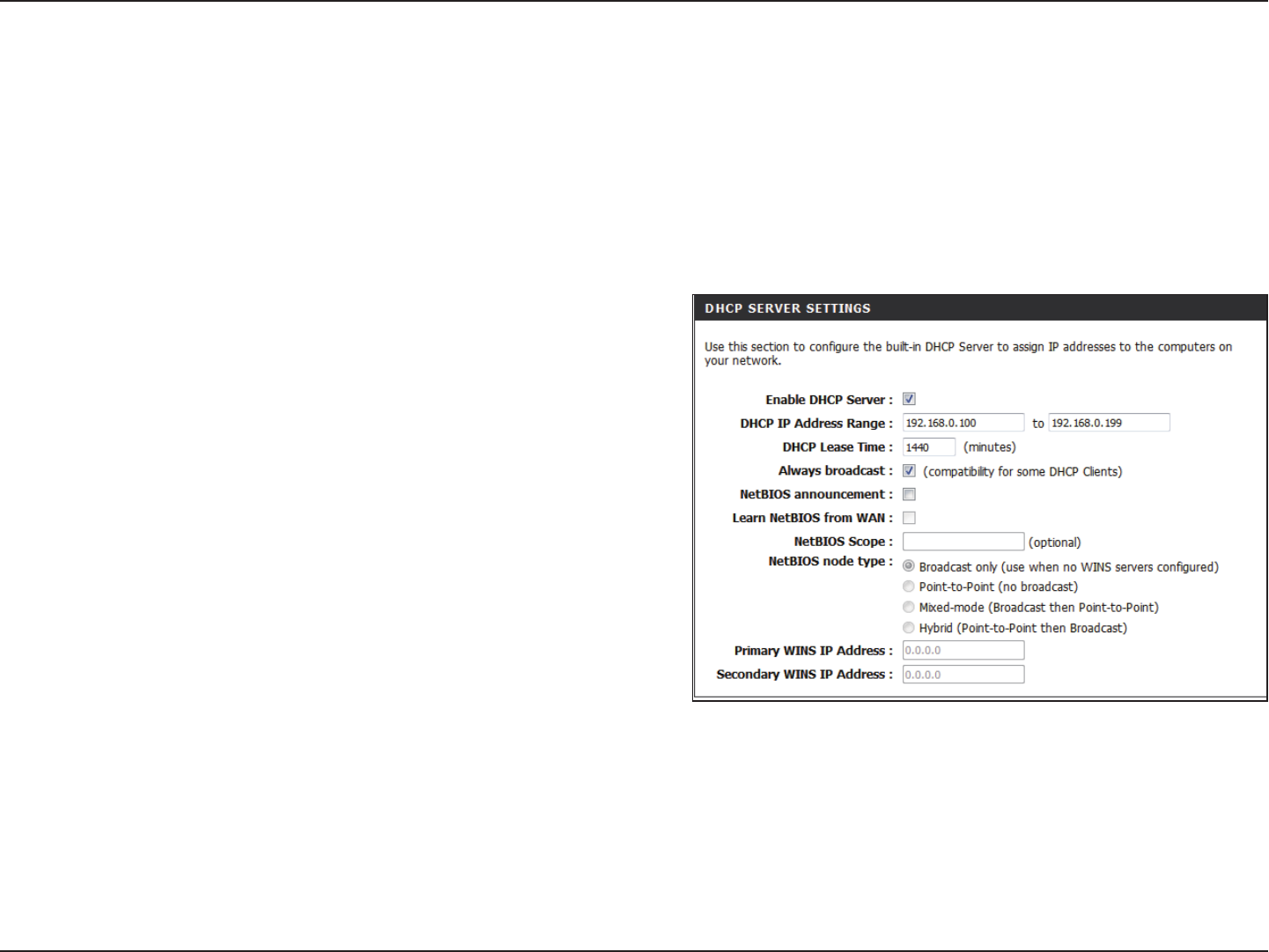
42D-Link DHP-1320 User Manual
Section 3 - Conguration
DHCP stands for Dynamic Host Control Protocol. The DHP-1320 has a built-in DHCP server. The DHCP Server will automatically assign an IP address
to the computers on the LAN/private network. Be sure to set your computers to be DHCP clients by setting their TCP/IP settings to “Obtain an IP
Address Automatically.” When you turn your computers on, they will automatically load the proper TCP/IP settings provided by the DHP-1320. The
DHCP Server will automatically allocate an unused IP address from the IP address pool to the requesting computer. You must specify the starting
and ending address of the IP address pool.
Check this box to enable the DHCP server on your router.
Uncheck to disable this function.
Enter the starting and ending IP addresses for the DHCP server’s
IP assignment.
Note: If you statically (manually) assign IP addresses to your
computers or devices, make sure the IP addresses are outside of
this range or you may have an IP conict.
The length of time for the IP address lease. Enter the Lease time
in minutes.
If NetBIOS advertisement is switched on, switching this setting
on causes WINS information to be learned from the WAN side,
if available. Turn this setting o to congure manually.
This is an advance setting and is normally left blank. This allows the conguration of NetBIOS domain name under which network
hosts operate. This setting has no eect if the “ Learn NetBIOS information form WAN is activated.
Enable DHCP
Server:
DHCP IP Address
Range:
DHCP Lease Time:
Learn NetBIOS
WAN:
NetBIOS scope:
Network Settings
DHCP Server Settings
When you have nished conguring the new DHCP Server Settings, click the Save Settings button at the top or bottom of the window.

43D-Link DHP-1320 User Manual
Section 3 - Conguration
If you want a computer or device to always have the same IP address assigned, you can create a DHCP reservation. The router will assign the IP
address only to that computer or device.
Note: This IP address must be within the DHCP IP Address Range.
Check this box to enable the reservation.
Enter the computer name. Alternatively, select a
computer that currently has a DHCP lease from the drop
down menu and click << to automatically populate the
Computer Name, IP Address, and MAC Address elds.
Enter the IP address you want to assign to the computer
or device. This IP Address must be within the DHCP IP
Address Range.
Enter the MAC address of the computer or device.
If you want to assign an IP address to the computer you
are currently on, click this button to populate the elds.
Click Save to save your entry. You must click Save Settings at the top to activate your reservations.
In this section you can see what LAN devices are currently leasing IP addresses.
Enable:
Computer
Name:
IP Address:
MAC Address:
Copy Your PC’s
MAC Address:
Save:
Dynamic DHCP
Clients:
Network Settings
DHCP Reservation
When you have nished conguring the new DHCP Reservation, click the Save Settings button at the top or bottom of the window to activate
your reservations.
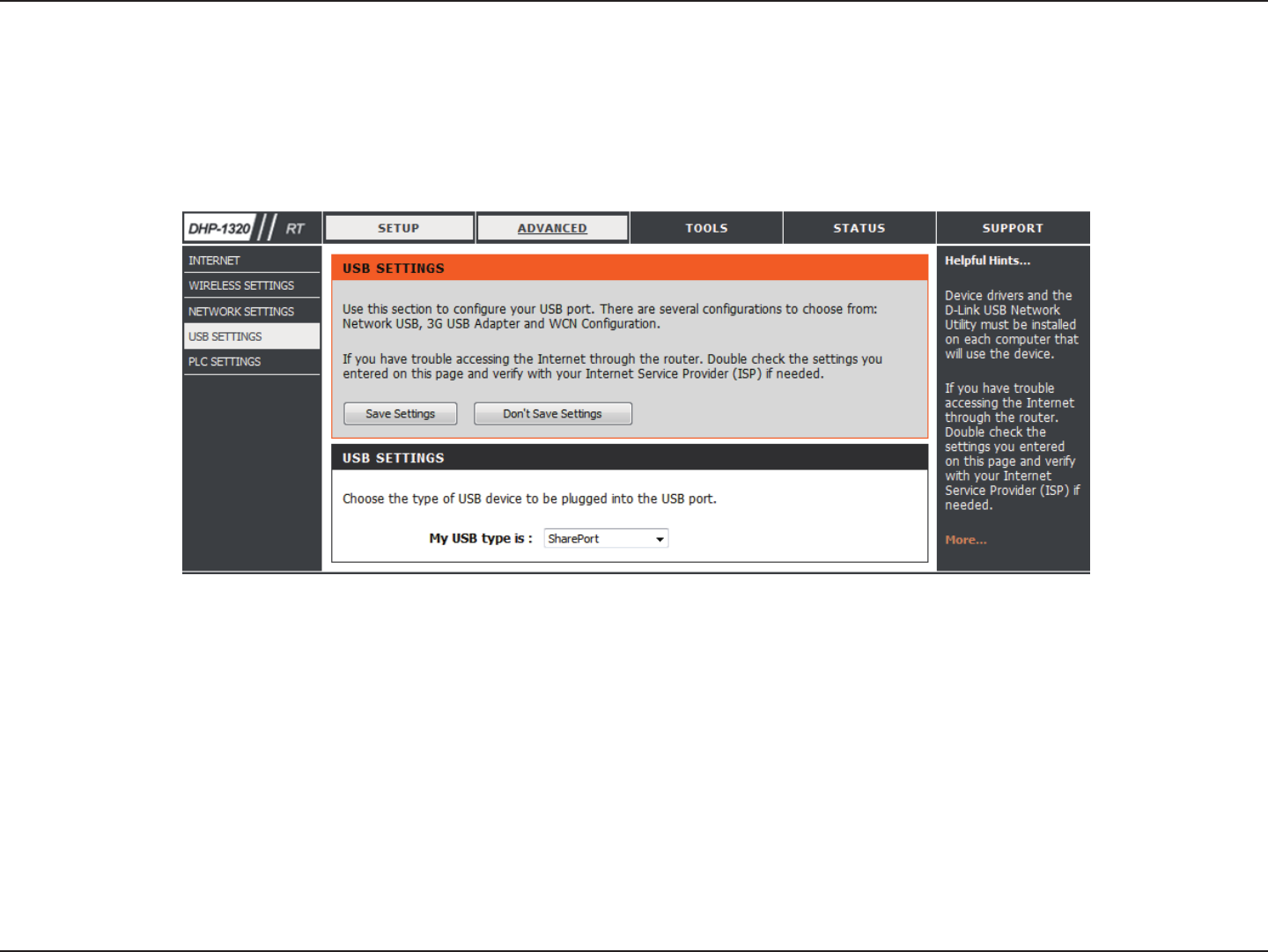
44D-Link DHP-1320 User Manual
Section 3 - Conguration
USB Settings
In this section you may congure your USB port. You can select several congurations to choose from such as Share Port and WCN Conguration.
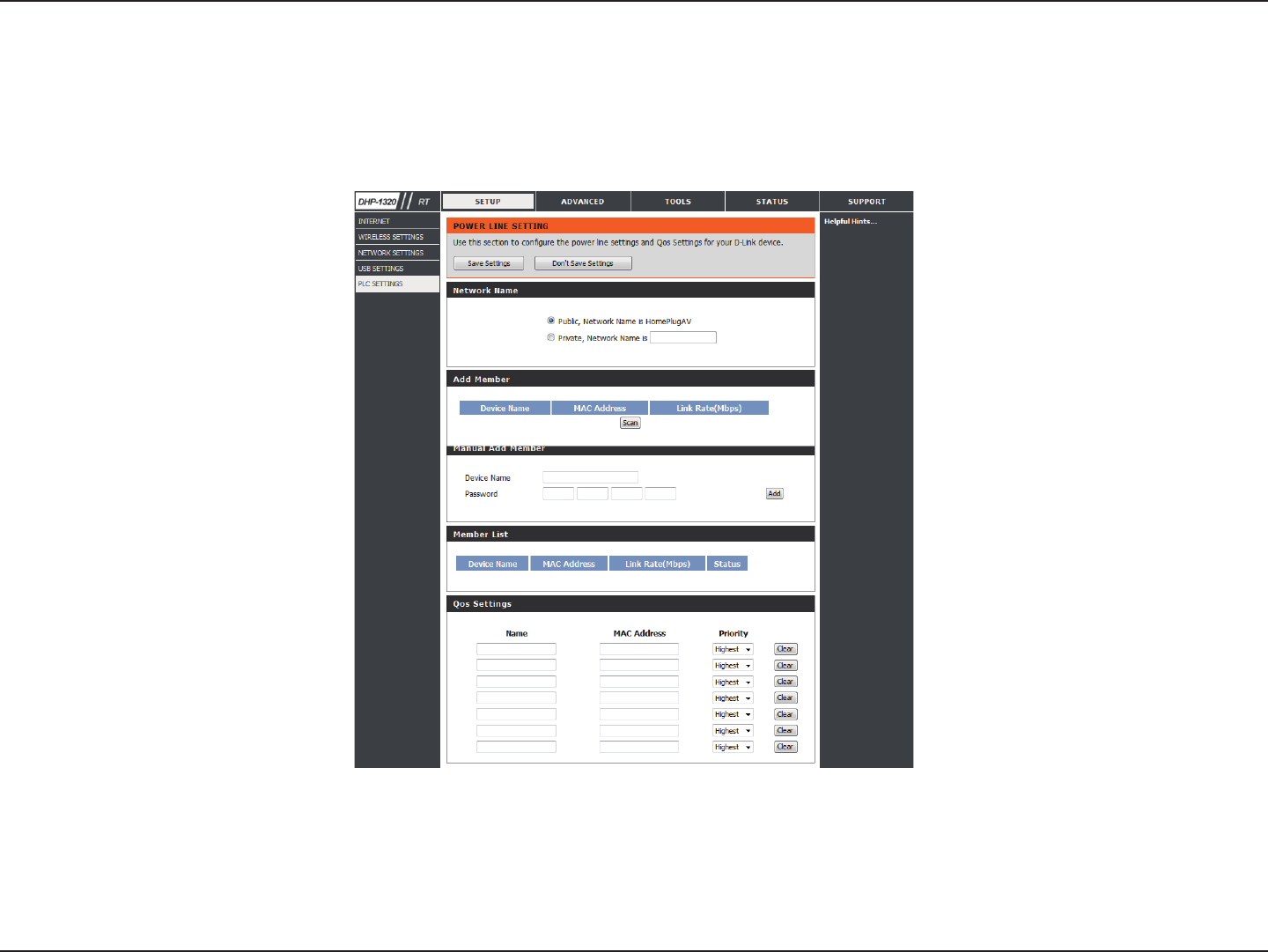
45D-Link DHP-1320 User Manual
Section 3 - Conguration
This section will show you how to congure your new D-Link PowerLine AV using the web-based conguration utility.
PLC Settings (Router Mode)
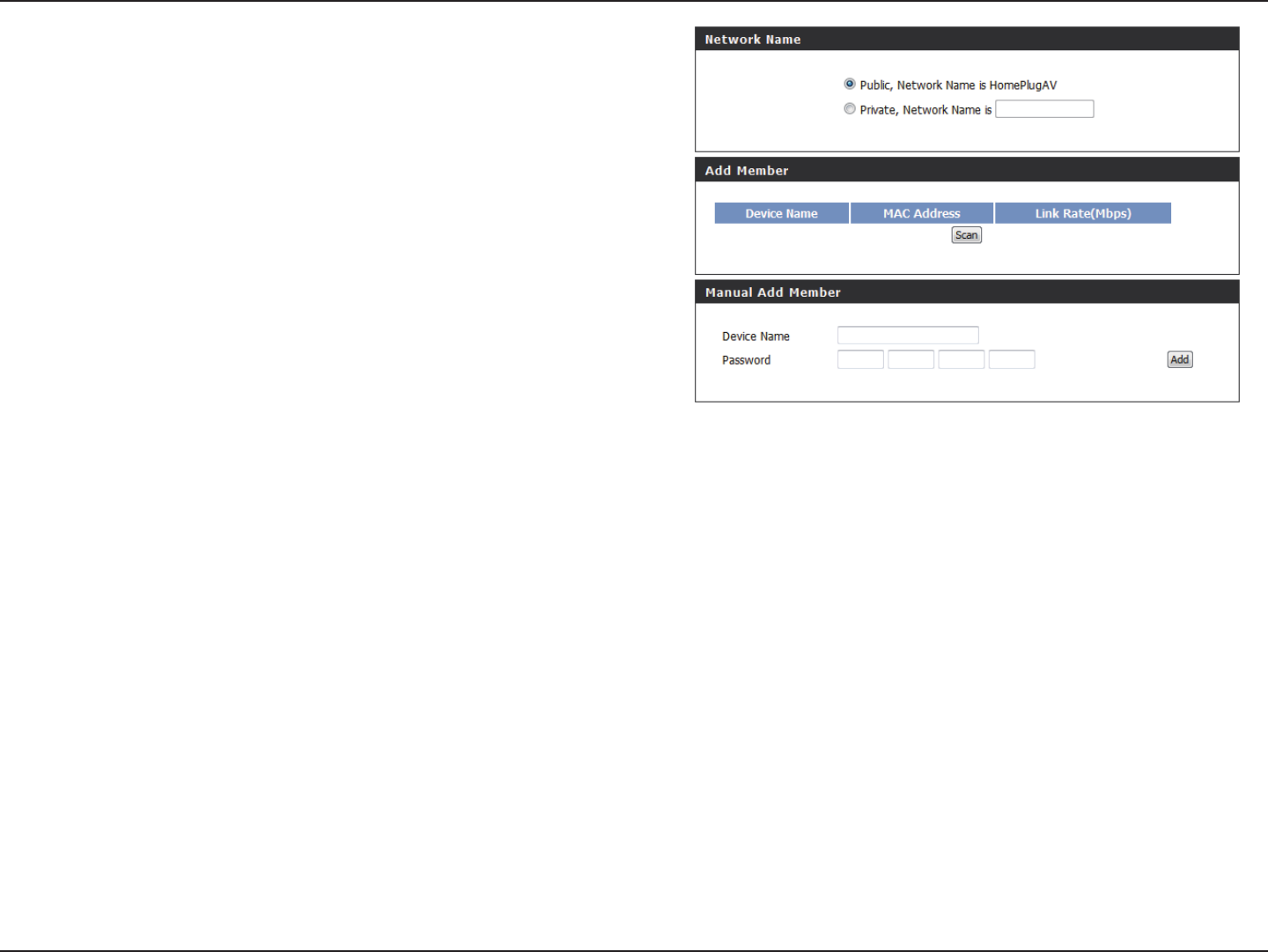
46D-Link DHP-1320 User Manual
Section 3 - Conguration
Network
Name:
Public
Network
Name:
Private
Network
Name:
Scan:
Add
Memeber:
Device Name:
Password:
You can set the name of your network and to make it
either public or private. Make sure the Network Name of
all of the devices within your PowerLine network is the
same.
Select this option if you would like to make your powerline
network public with the default Network Name of
“HomePlugAV”. Since this is a commonly used Network
Name, it is less secure than a private Network Name.
Select this option if you wish to make your powerline
network more secure by using a private Network Name.
Type the name of your private PowerLine network in the
eld.
Scan for new PowerLine devices.
This section lets you add new PowerLine AV devices to
your PowerLine network. To add a new device, give it a
Device Name and enter its Password, then click Add. When
you add a device it is given the current Network Name.
Type a name you wish to use to identify a specific
PowerLine AV device. For example, “Jack’s room”.
The Password is used to verify that you are authorized to
perform changes on a device. You can
nd the Password printed on the back of your device.
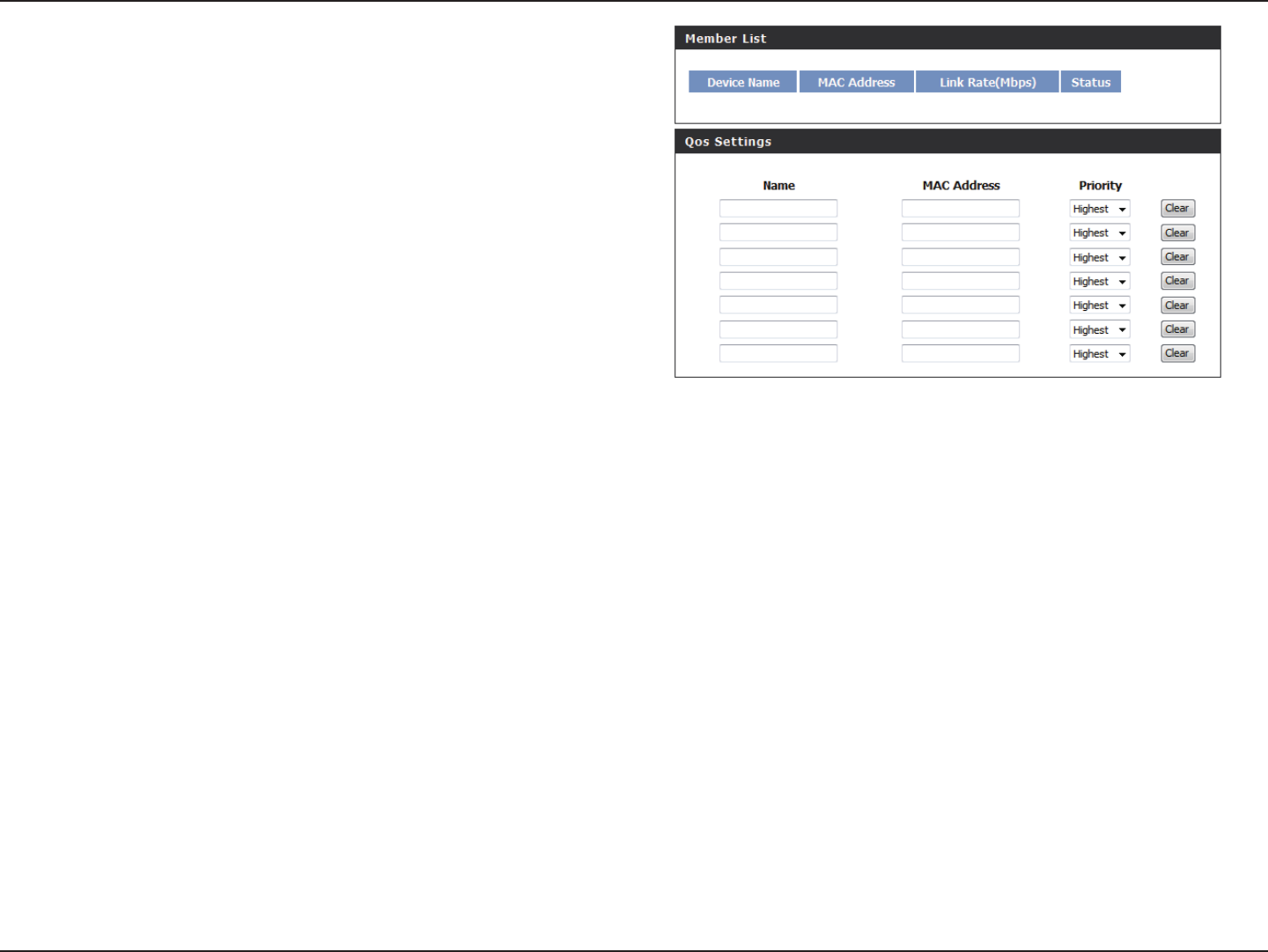
47D-Link DHP-1320 User Manual
Section 3 - Conguration
Member List:
Link Rate:
This section provides information on the PowerLine
AV devices in your PowerLine network, or any devices
that were previously connected but it are currently
disconnected.
Displays the device’s current data rate in Mbps.
Status:
Qos Settings:
Mac Address:
This field shows the status of the device. If the field
displays the word Connect, then the device is connected
to your PowerLine network. If the eld displays the word
Disconnect, then the device has been added to the
network but it is not ready. Please check its password and
make sure the device is
powered on.
You can congure your PowerLine AV devices to give
priority to powerline network trac accordingly. Enter the
name, MAC Address, and priority level.
You can nd the MAC address printed on the back of your
device.

48D-Link DHP-1320 User Manual
Section 3 - Conguration
The DHP-1320 can be congured as a virtual server so that remote users accessing Web or FTP services via the public IP address can be automatically
redirected to local servers in the LAN (Local Area Network).
The DHP-1320 rewall feature lters out unrecognized packets to protect your LAN network so all computers networked with the DHP-1320
are invisible to the outside world. If you wish, you can make some of the LAN computers accessible from the Internet by enabling Virtual Server.
Depending on the requested service, the DHP-1320 redirects the external service request to the appropriate server within the LAN network.
The DHP-1320 is also capable of port-redirection, meaning that incoming trac to a particular port may be redirected to a dierent port on the
server computer.
For a list of ports for common applications, please visit http://support.dlink.com/faq.
Virtual Server
Advanced
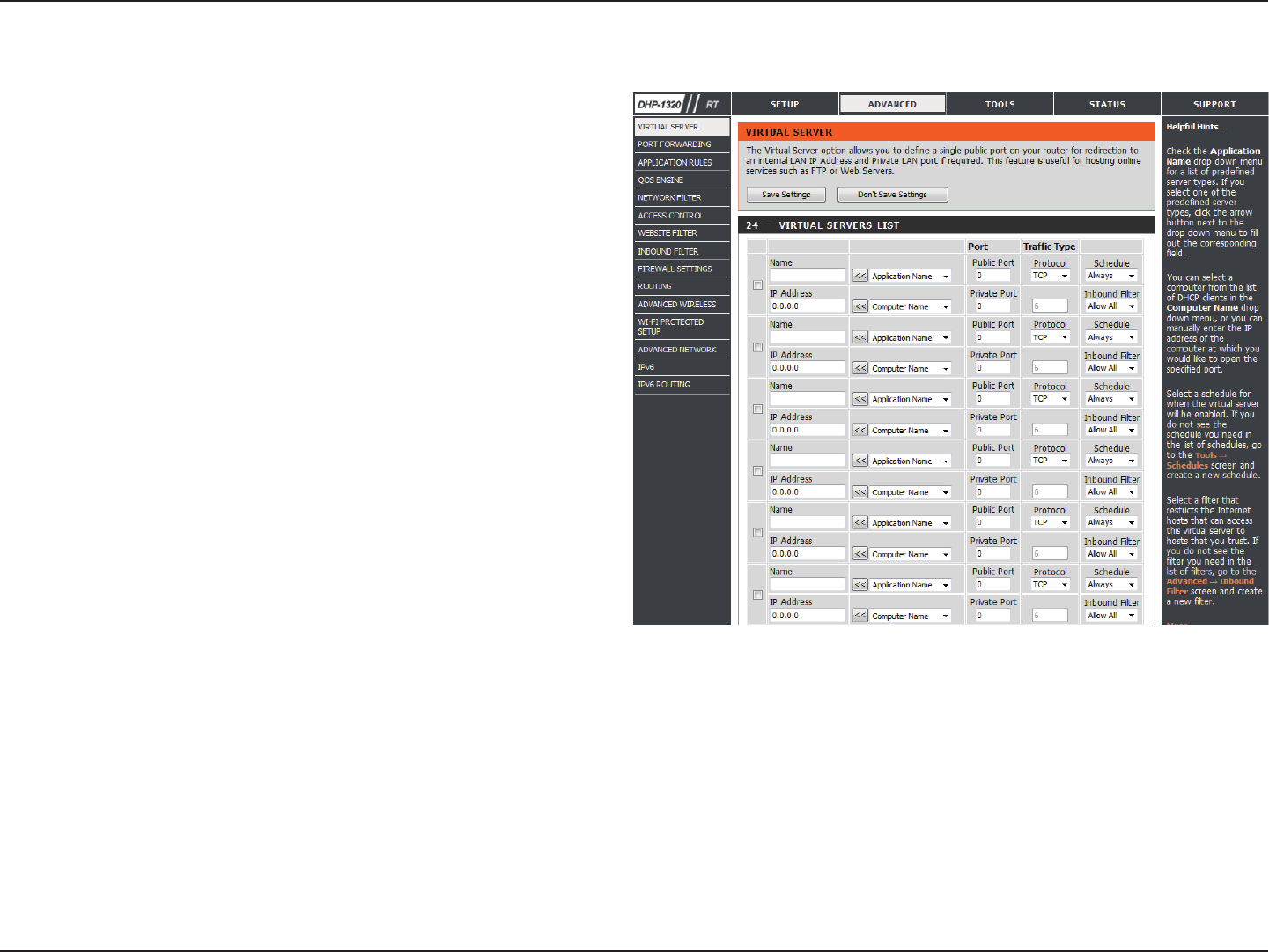
49D-Link DHP-1320 User Manual
Section 3 - Conguration
The Virtual Server window allows you to open a single port. If you would like to open a range of ports, refer to the next page.
Check the box on the left side to enable the Virtual
Server rule.
Enter a name for the rule or select an application from
the drop-down menu. Select an application and click
<< to populate the elds.
Enter the IP address of the computer on your local
network that you want to allow the incoming service to.
If your computer is receiving an IP address automatically
from the router (DHCP), you computer will be listed in
the Computer Name drop-down menu. Select your
computer and click <<.
Enter the port that you want to open next to Public
Port and Private Port. The public and private ports are
usually the same. The public port is the port seen from
the Internet side, and the private port is the port being
used by the application on the computer within your
local network.
Select TCP, UDP, Both or other from the Protocol drop-
down menu.
Use the drop-down menu to schedule the time that the Virtual Server Rule will be enabled. The schedule may be set to Always,
which will allow the particular service to always be enabled. You can create your own times in the Tools > Schedules section.
Select Allow All (most common) or a created Inbound lter. You may create your own inbound lters in the Advanced > Inbound
Filter page.
Enable
Checkbox:
Name:
IP Address:
Public Port/
Private Port:
Trac Type:
Schedule
Drop-Down
Menu:
Inbound Filter:
Click the Save Settings button to save any changes made.

50D-Link DHP-1320 User Manual
Section 3 - Conguration
This will allow you to open a single port or a range of ports.
Port Forwarding
Tick the checkbox on the left side to enable the Port
Forwarding rule.
Enter a name for the rule or select an application
from the drop-down menu. Select an application
and click << to populate the elds.
Enter the IP address of the computer on your local
network that you want to allow the incoming service
to. If your computer is receiving an IP address
automatically from the router (DHCP), you computer
will be listed in the Computer Name drop-down
menu. Select your computer and click <<.
Enter the port that you want to open next to TCP
Port and UDP Port.
Use the drop-down menu to schedule the time
that the Port Forwarding rule will be enabled. The
schedule may be set to Always, which will allow
the particular service to always be enabled. You can
create your own times in the Tools > Schedules
section.
Select Allow All (most common) or a created
Inbound lter. You may create your own inbound
lters in the Advanced > Inbound Filter page.
Enable Checkbox:
Name:
IP Address:
TCP Port/
UDP Port:
Schedule:
Inbound Filter:
Click the Save Settings button to save any changes made.
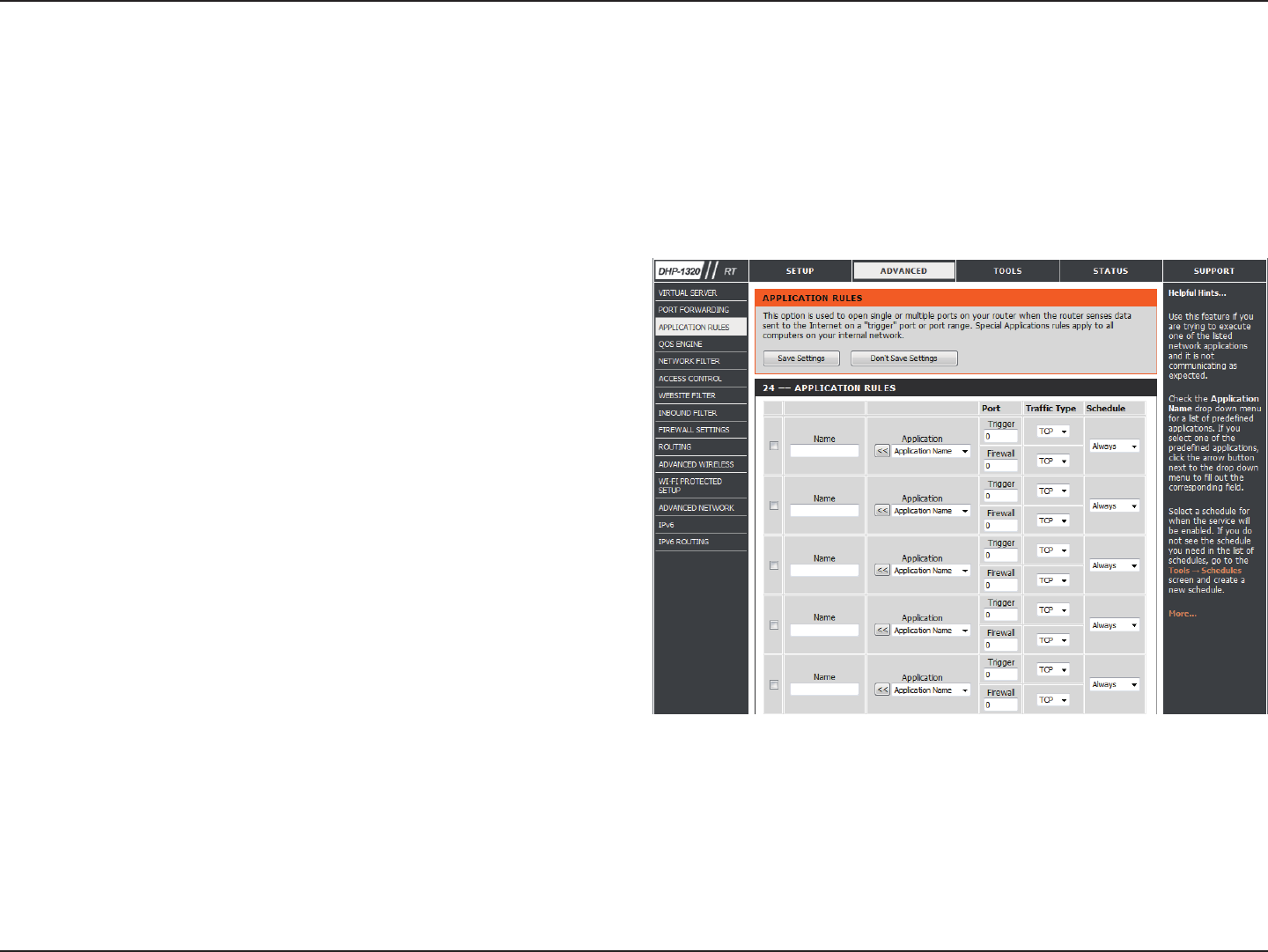
51D-Link DHP-1320 User Manual
Section 3 - Conguration
Check the box on the left side to enable the Application
Rule.
Enter a name for the rule. You may select a pre-dened
application from the Application drop-down menu and
click <<.
This is the port used to trigger the application. It can be
either a single port or a range of ports.
Select the protocol of the trigger port (TCP, UDP, or Any).
This is the port number on the Internet side that will be
used to access the application. You may dene a single port
or a range of ports. You can use a comma to add multiple
ports or port ranges.
Select the protocol of the rewall port (TCP or UDP).
The schedule of time when the Application Rule will be
enabled. The schedule may be set to Always, which will
allow the particular service to always be enabled. You can
create your own times in the Tools > Schedules section.
Enable Checkbox:
Name:
Trigger:
Trac Type:
Firewall:
Trac Type:
Schedule:
Application Rules
Some applications require multiple connections, such as Internet gaming, video conferencing, Internet telephony and others. These applications
have diculties working through NAT (Network Address Translation). Special Applications makes some of these applications work with the DHP-
1320. If you need to run applications that require multiple connections, specify the port normally associated with an application in the “Trigger Port”
eld, select the protocol type as TCP or UDP, then enter the rewall (public) ports associated with the trigger port to open them for inbound trac.
Click the Save Settings button to save any changes made.
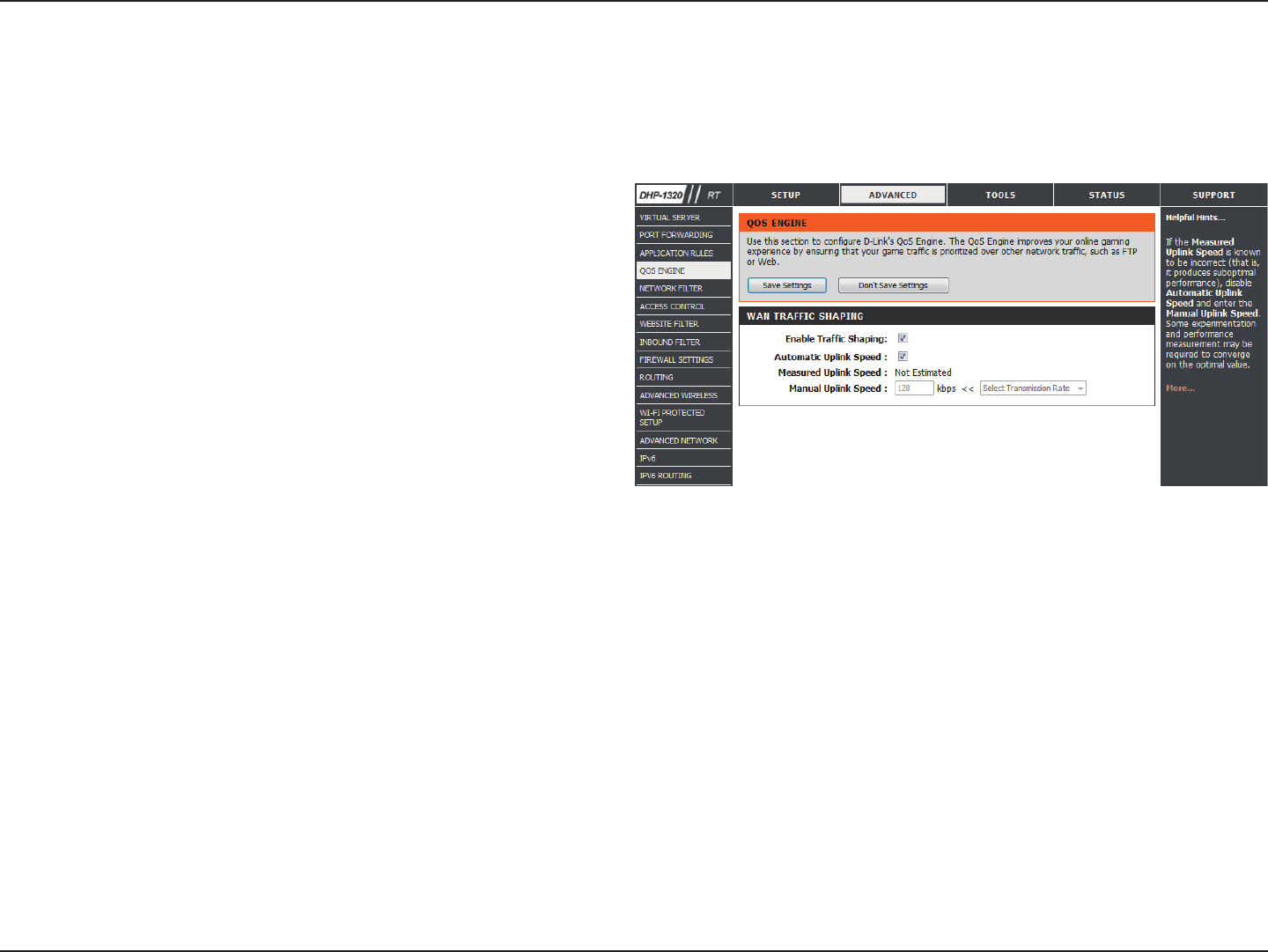
52D-Link DHP-1320 User Manual
Section 3 - Conguration
QoS Engine
This option is disabled by default. Enable this option
for better performance and experience with online
games and other interactive applications, such as VoIP.
This option is enabled by default when the QoS Engine
option is enabled. This option will allow your router
to automatically determine the uplink speed of your
Internet connection.
This displays the detected uplink speed.
The speed at which data can be transferred from the
router to your ISP. This is determined by your ISP. ISP’s
often dene speed as a download/upload pair. For
example, 1.5Mbits/284Kbits. Using this example, you
would enter 284. Alternatively you can test your uplink
speed with a service such as www.dslreports.com.
Enable Trac
Shapping:
Automatic Uplink
Speed:
Measured Uplink
Speed:
Manual Uplink
Speed:
The QoS Engine option helps improve your network gaming performance by prioritizing applications. By default the QoS Engine settings are
disabled and application priority is not classied automatically.
Click the Save Settings button to save any changes made.

53D-Link DHP-1320 User Manual
Section 3 - Conguration
Network Filter
Select Turn MAC Filtering OFF, Turn MAC Filtering ON
and ALLOW computers listed to access the network, or
Turn MAC Filtering ON and DENY computers listed to
access the network from the drop-down menu.
Enter the MAC address you would like to lter.
To nd the MAC address on a computer, please refer to
the Networking Basics section in this manual.
Select a DHCP client from the Computer Name drop
down menu and click << to copy that MAC Address.
Congure MAC
Filtering:
MAC Address:
DHCP Client List:
Use MAC (Media Access Control) Filters to allow or deny LAN (Local Area Network) computers by their MAC addresses from accessing the network.
You can either manually add a MAC address or select the MAC address from the list of clients that are currently connected to the Broadband Router.
Click the Save Settings button to save any changes made.

54D-Link DHP-1320 User Manual
Section 3 - Conguration
Access Control
Check the Enable Access Control check box and
click the Add Policy button to start the Access
Control Wizard.
Add Policy:
The Access Control section allows you to control access in and out of your network. Use this feature as Parental Controls to only grant access to
approved sites, limit web access based on time or dates, and/or block access from applications like P2P utilities or games.
Click Next to continue with the wizard.
Access Control Wizard

55D-Link DHP-1320 User Manual
Section 3 - Conguration
Enter a name for the policy and then click Next to continue.
Select a schedule (I.E. Always) from the drop-down menu and
then click Next to continue.
Enter the following information and then click Next to continue.
• Address Type - Select IP address, MAC address, or Other Machines.
• IP Address - Enter the IP address of the computer you want to apply
the rule to.

56D-Link DHP-1320 User Manual
Section 3 - Conguration
Select the ltering method and then click Next to continue.
Enter the rule:
Enable - Check to enable the rule.
Name - Enter a name for your rule.
Dest IP Start - Enter the starting IP address.
Dest IP End - Enter the ending IP address.
Protocol - Select the protocol.
Dest Port Start - Enter the starting port number.
Dest Port End - Enter the ending port number.
To enable web logging, click Enable.
Click Save to save the access control rule.
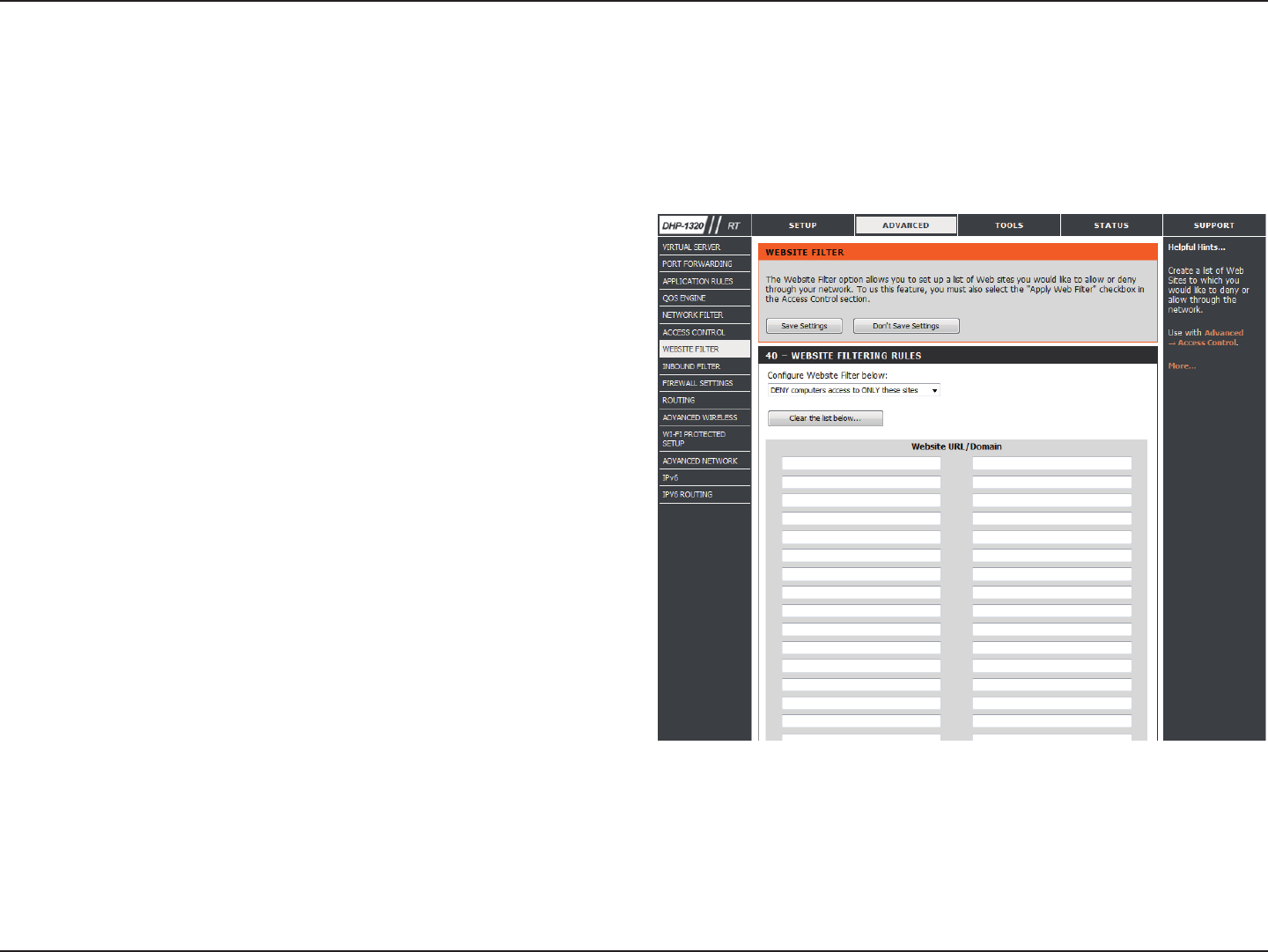
57D-Link DHP-1320 User Manual
Section 3 - Conguration
Congure Web
Filtering:
Website URL:
Website Filter
Select ALLOW computers access to ONLY these sites, or
DENY computers access to ONLY these sites from the
drop-down menu.
Enter the keywords or URLs that you want to allow or block.
Website Filters are used to allow you to set up a list of Web sites that can be viewed by multiple users through the network. To use this feature select
the appropriate Web Filtering option, enter the domain or website, and click Save Settings.
Click the Save Settings button to save any changes made.
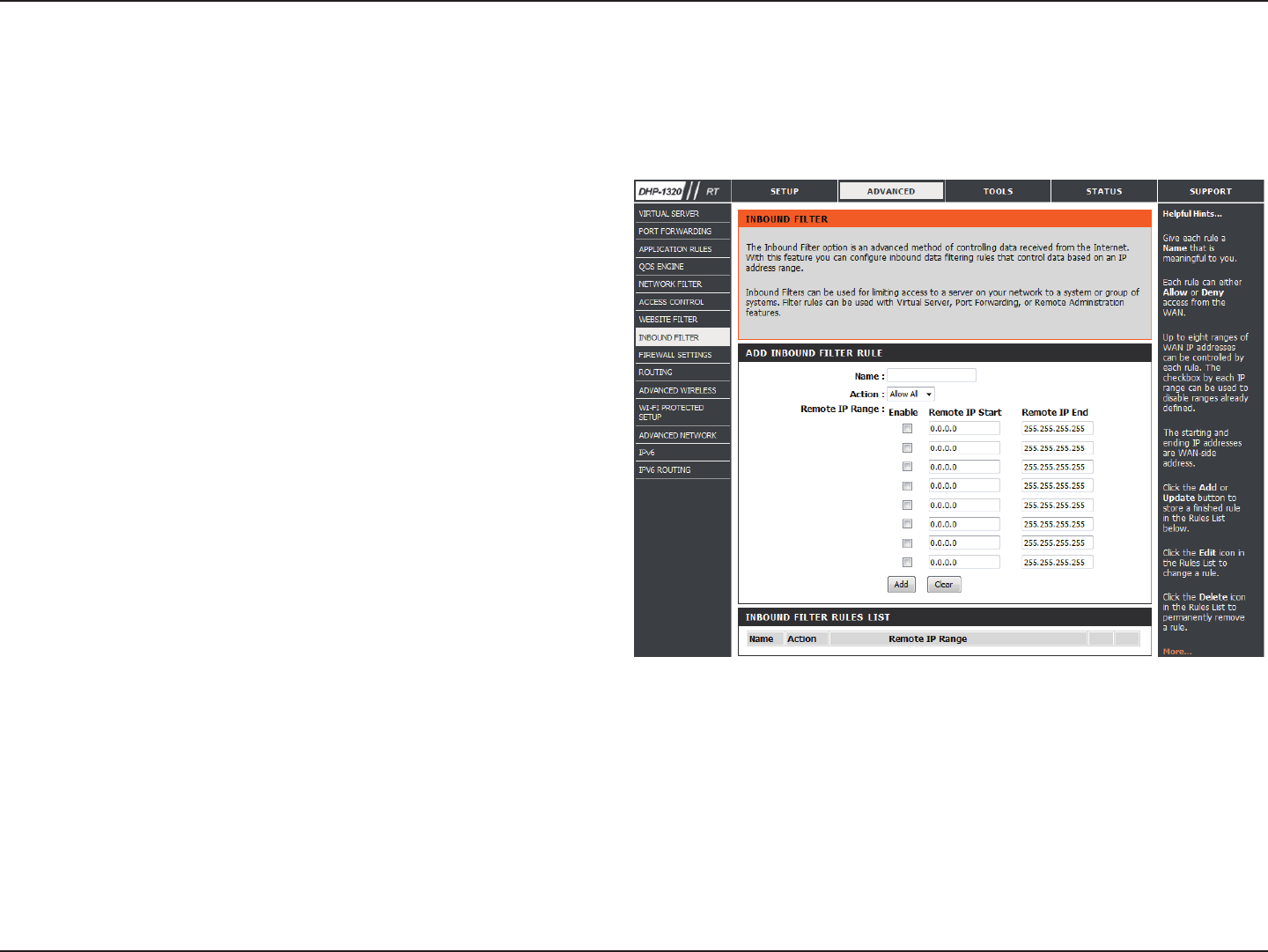
58D-Link DHP-1320 User Manual
Section 3 - Conguration
Inbound Filter
Enter a name for the inbound lter rule.
Select Allow or Deny.
Check to enable rule.
Enter the starting IP address. Enter 0.0.0.0 if you
do not want to specify an IP range.
Enter the ending IP address. Enter 255.255.255.255
if you do not want to specify and IP range.
Click the Add button to apply your settings.
Name:
Action:
Enable:
Remote IP
Start:
Remote IP
End:
Add:
The Inbound Filter option is an advanced method of controlling data received from the Internet. With this feature you can congure inbound
data ltering rules that control data based on an IP address range. Inbound Filters can be used with Virtual Server, Port Forwarding, or Remote
Administration features.
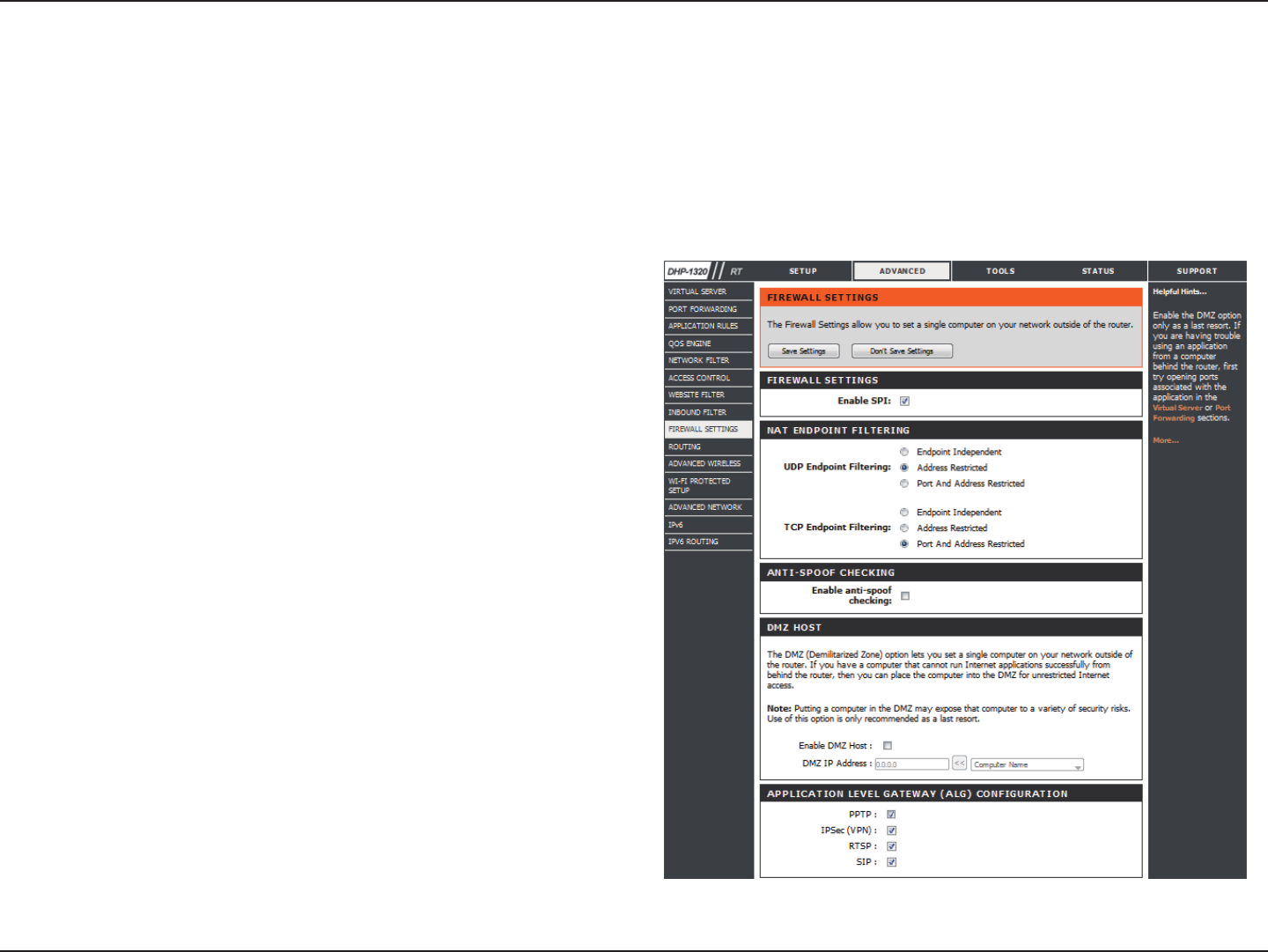
59D-Link DHP-1320 User Manual
Section 3 - Conguration
Check the Enable SPI box to enable the SPI (Stateful
Packet Inspection, also known as dynamic packet ltering)
feature. Enabling SPI helps to prevent cyber attacks by
tracking more state per session. It validates that the trac
passing through the session conforms to the protocol.
Select one of the following for TCP and UDP ports:
Endpoint Independent - Any incoming trac sent to
an open port will be forwarded to the application that
opened the port. The port will close if idle for 5 minutes.
Address Restricted - Incoming trac must match the IP
address of the outgoing connection.
Address + Port Restriction - Incoming trac must match
the IP address and port of the outgoing connection.
Enable this option to provide protection from certain kinds
of “spoong” attacks.
Firewall Settings:
NAT Endpoint
Filtering:
Enable Anti-Spoof
Checking:
Firewall Settings
A rewall protects your network from the outside world. The DHP-1320 oers a rewall type functionality. The SPI feature helps prevent cyber
attacks. Sometimes you may want a computer exposed to the outside world for certain types of applications. If you choose to expose a computer,
you can enable DMZ. DMZ is short for Demilitarized Zone. This option will expose the chosen computer completely to the outside world.

60D-Link DHP-1320 User Manual
Section 3 - Conguration
1. Check the Enable DMZ box.
2. Specify the IP address of the computer on the
LAN that you want to have unrestricted Internet
communication in the DMZ IP address eld. To
specify an existing DHCP client, use the Computer
Name drop-down to select the computer that
you want to make a DMZ host. If selecting a
computer that is a DHCP client, be sure to make
a static reservation in the Setup > Network
Settings page so that the IP address of the DMZ
machine does not change.
3. Click the Save Settings button to add the new
DMZ host.
DMZ Host:
IP Address: Specify the IP address of the computer on the LAN that you want to have unrestricted Internet communication. If this computer
obtains its IP address automatically using DHCP, be sure to make a static reservation on the System > Network Settings page so
that the IP address of the DMZ machine does not change.
If an application has trouble working from behind the router, you can expose one computer to the Internet and run the application
on that computer.
Carry out the following to create a DMZ host:

61D-Link DHP-1320 User Manual
Section 3 - Conguration
Routing
The Routing option is an advanced method of customizing specic routes of data through your network.
Click the Save Settings button to save any changes made.
Routing List:
Name:
Interface:
Destination IP:
Netmask:
Gateway:
Each Route has a checkbox next to it, check the box
of the route you wish to enable.
Specify a name for identication of this route.
Select the interface which the IP packet must use to
transit out of the router when this route is used.
Enter the address of the host or network you wish
to access.
This eld identies the portion of the destination IP
in use.
The IP address of the router will be displayed here.
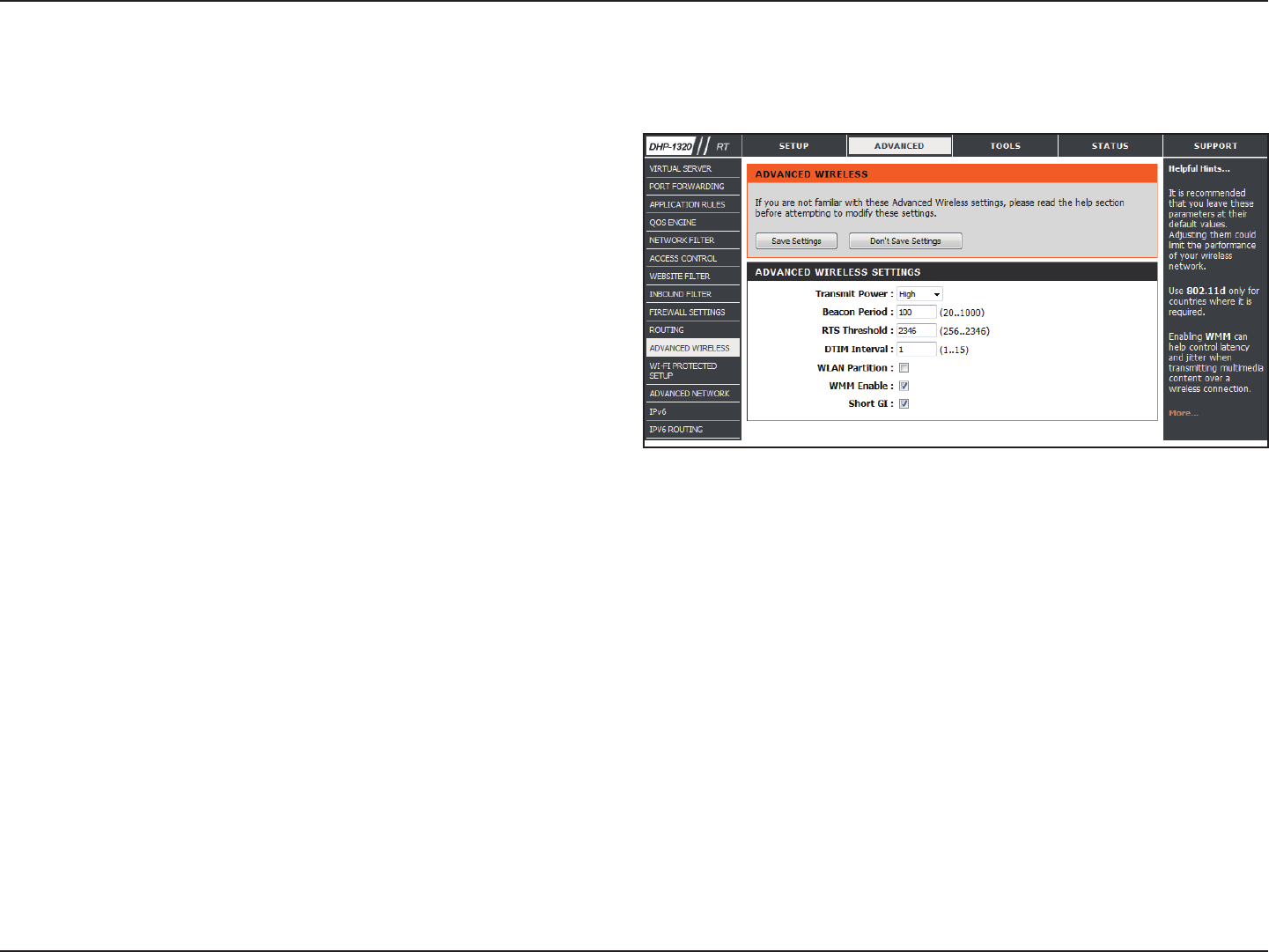
62D-Link DHP-1320 User Manual
Section 3 - Conguration
Set the transmit power of the antennas.
Beacons are packets sent by an Access Point to
synchronize a wireless network. Specify a value. 100 is
the default setting and is recommended.
This value should remain at its default setting of 2346.
If inconsistent data flow is a problem, only a minor
modication should be made.
(Delivery Trac Indication Message) 1 is the default
setting. A DTIM is a countdown informing clients of the
next window for listening to broadcast and multicast
messages.
This enables 802.11d operation. 802.11d is a wireless specication developed to allow implementation of wireless networks in
countries that cannot use the 802.11 standard. This feature should only be enabled if you are in a country that requires it.
WMM is QoS for your wireless network. This will improve the quality of video and voice applications for your wireless clients.
Transmit Power:
Beacon Period:
RTS Threshold:
DTIM Interval:
WLAN Partition:
WMM Enable:
Advanced Wireless Settings
802.11n/b/g (2.4GHz)
Check this box to reduce the guard interval time therefore increasing the data capacity. However, it’s less reliable and may create
higher data loss.
Short Guard
Interval:
Click the Save Settings button to save any changes made.
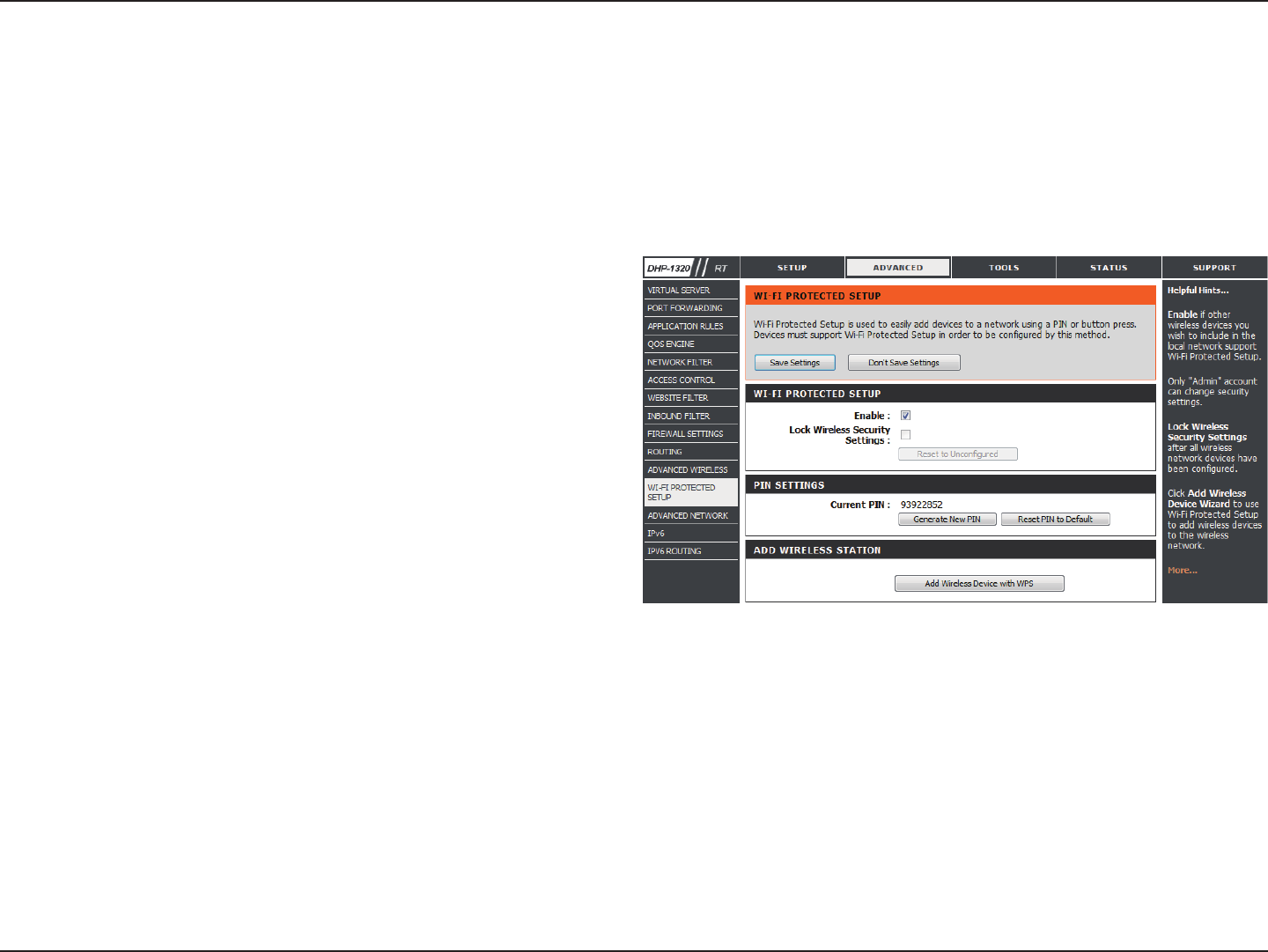
63D-Link DHP-1320 User Manual
Section 3 - Conguration
Wi-Fi Protected Setup (WPS)
Enable the Wi-Fi Protected Setup feature.
A PIN is a unique number that can be used to add the
router to an existing network or to create a new network.
The default PIN may be printed on the bottom of the
router. For extra security, a new PIN can be generated.
You can restore the default PIN at any time. Only the
Administrator (“admin” account) can change or reset
the PIN.
Shows the current value of the router’s PIN.
Click this button to restore the default PIN of the router.
Click this button to create a random number that is a
valid PIN. This becomes the router’s PIN. You can then
copy this PIN to the user interface of the registrar.
Enable:
PIN Settings:
PIN:
Reset PIN to
Default:
Generate New
PIN:
Wi-Fi Protected Setup (WPS) System is a simplied method for securing your wireless network during the “Initial setup” as well as the “Add New
Device” processes. The Wi-Fi Alliance (WFA) has certied it across dierent products as well as manufactures. The process is just as easy, as depressing
a button for the Push-Button Method or correctly entering the 8-digit code for the Pin-Code Method. The time reduction in setup and ease of use
are quite benecial, while the highest wireless Security setting of WPA2 is automatically used.

64D-Link DHP-1320 User Manual
Section 3 - Conguration
Click the Add Wireless Device with WPS button to start Wireless Connection Setup Wizard. This wizard helps you add wireless
devices to the wireless network.
The wizard will either display the wireless network settings to guide you through manual conguration, prompt you to enter the
PIN for the device, or ask you to press the conguration button on the device. If the device supports Wi-Fi Protected Setup and has a
conguration button, you can add it to the network by pressing the conguration button on the device and then the on the router
within 60 seconds. The status LED on the router will ash three times if the device has been successfully added to the network.
There are several ways to add a wireless device to your network. A “registrar” controls access to the wireless network. A registrar
only allows devices onto the wireless network if you have entered the PIN, or pressed a special Wi-Fi Protected Setup button on the
device. The router acts as a registrar for the network, although other devices may act as a registrar as well.
Add Wireless
Station:
Click the Save Settings button to save any changes made.

65D-Link DHP-1320 User Manual
Section 3 - Conguration
UPnP
Internet Ping Block
Internet Port Speed
Multicast Streams
To use the Universal Plug and Play (UPnP™) feature click on
Enabled. UPNP provides compatibility with networking
equipment, software and peripherals.
Unchecking the box will not allow the DHP-1320 to
respond to pings. Blocking the Ping may provide some
extra security from hackers. Check the box to allow the
Internet port to be “pinged”.
You may set the port speed of the Internet port to 10Mbps,
100Mbps, or auto. Some older cable or DSL modems may
require you to set the port speed to 10Mbps.
Check the Enable Multicast Streams box to allow multicast
trac to pass through the router from the Internet.
Enable UPnP:
Enable WAN Ping
Response:
WAN Port Speed:
Enable Multicast
Streams:
Advanced Network
Click the Save Settings button to save any changes made.
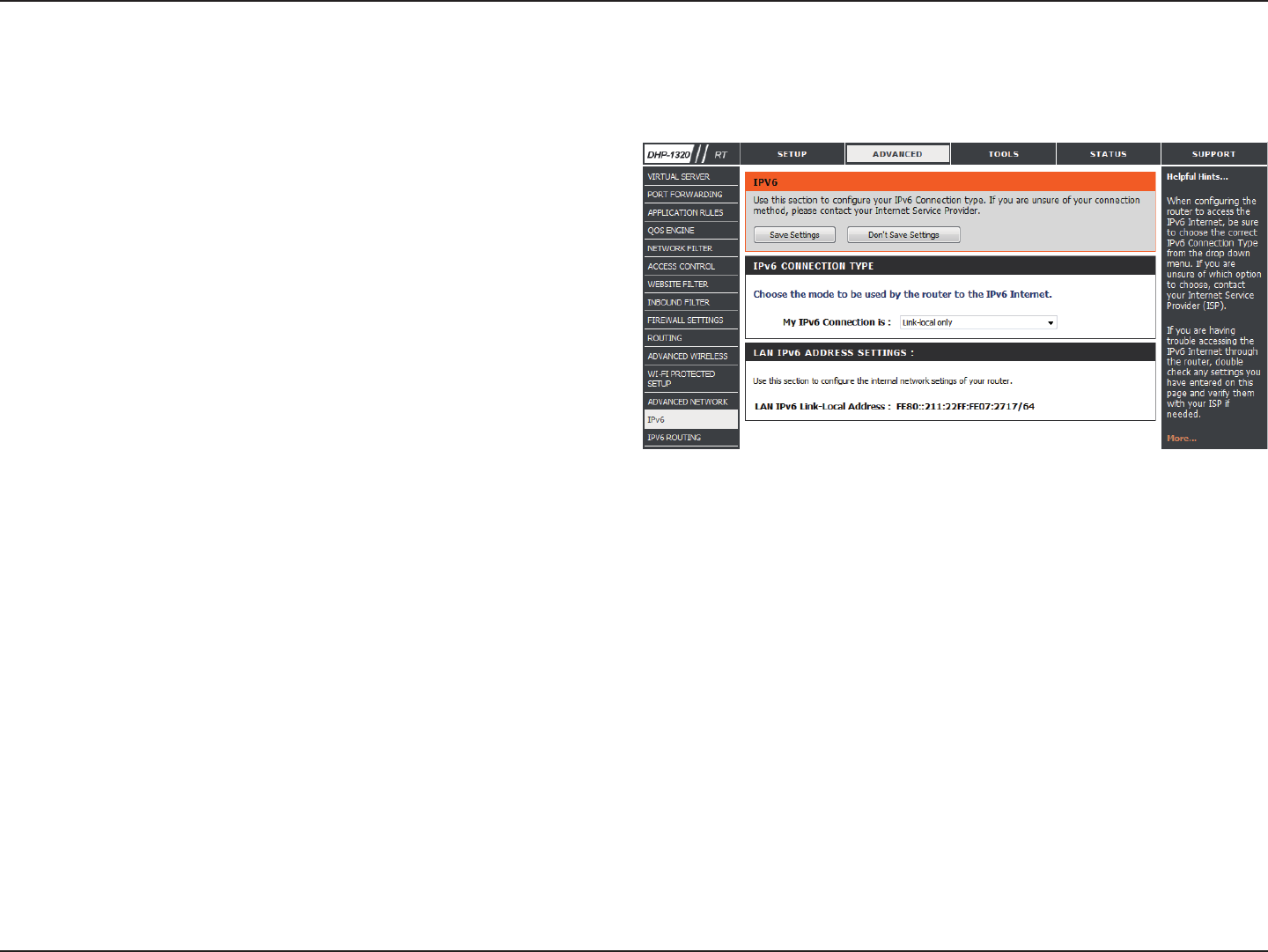
66D-Link DHP-1320 User Manual
Section 3 - Conguration
IPv6
Use the drop-down menu to select the IPv6
Internet Connection mode.
My IPv6
Connection is:
Use the IPv6 window to congure the mode that the Router will use to access an IPv6 Internet connection.

67D-Link DHP-1320 User Manual
Section 3 - Conguration
IPv6
Static IPv6
Select Static IPv6 from the My IPv6 Connection is drop-down menu if your Router will use a static IPv6 address to connect
to the Internet.
Enter the address settings supplied by your Internet
provider (ISP).
Enter the LAN (local) IPv6 address for the router.
Use this section to congure the IPv6 autoconguration
settings.
WAN IPv6 Address
Settings:
LAN IPv6 Address:
LAN Address
Autoconguration
Settings:
Click the Save Settings button to save any changes made.
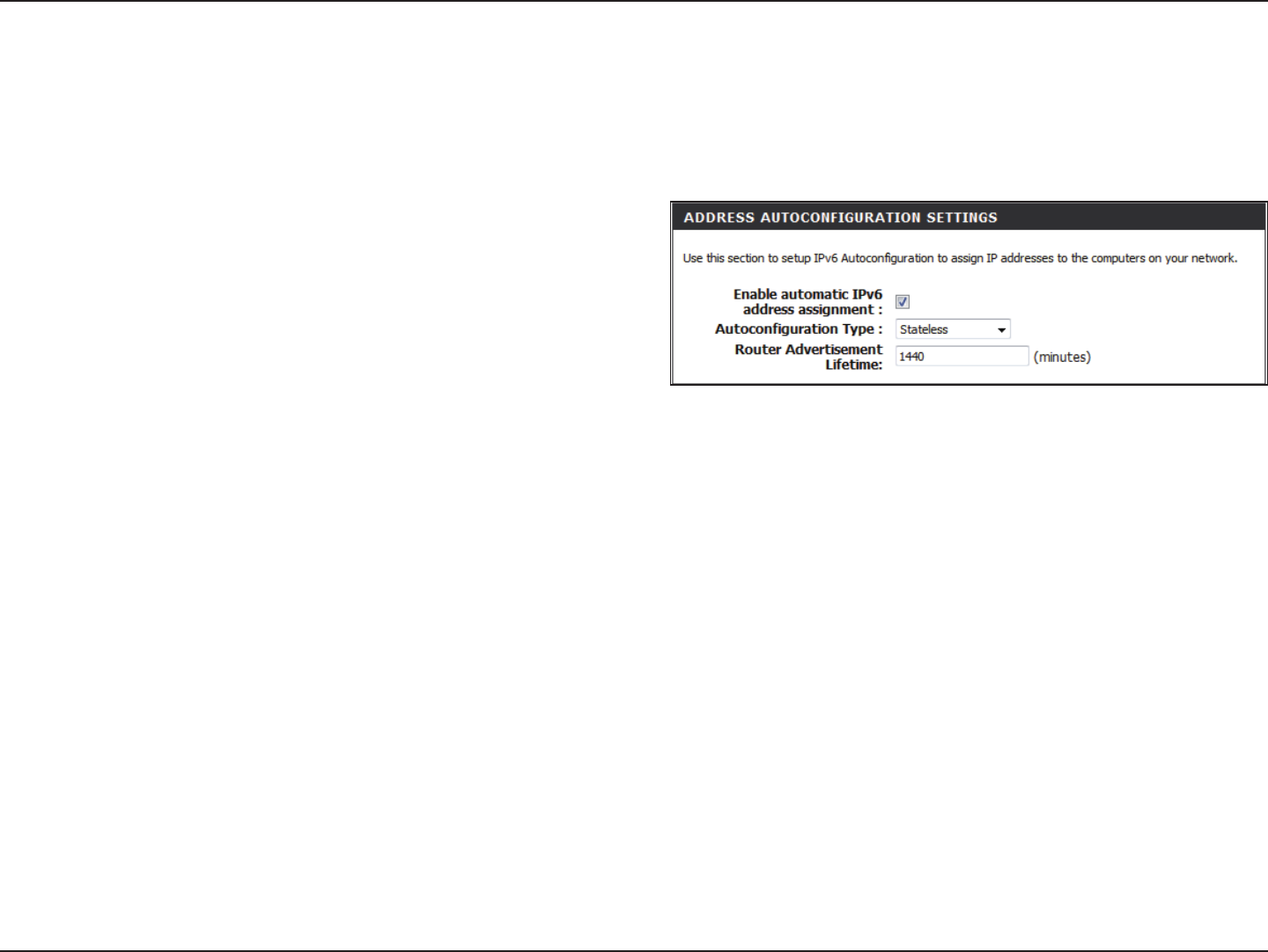
68D-Link DHP-1320 User Manual
Section 3 - Conguration
IPv6
Static IPv6 - Stateless
To congure the Router to use a Static IPv6 Stateless connection, congure the parameters in the LAN Address Autoconguration
Settings section as described below:
Check to enable the Autoconguration feature.
Select the Stateless option from the drop-down menu.
Enter the Router Advertisement Lifetime (in minutes).
Enable automatic
IPV6 address
assignment:
Autoconguration
Type:
Router
Advertisement
Lifetime:
Click the Save Settings button to save any changes made.

69D-Link DHP-1320 User Manual
Section 3 - Conguration
IPv6
Static IPv6 - Stateful
To congure the Router to use a Static IPv6 Stateful connection, congure the parameters in the LAN Address Autoconguration
Settings section as described below:
Check to enable the Autoconguration feature.
Select the Stateful(DHCPv6) option from the drop-down
menu.
Enter the start IPv6 Address for the DHCPv6 range for your
local computers.
Enter the end IPv6 Address for the DHCPv6 range for your
local computers.
Enter the IPv6 Address Lifetime (in minutes).
Enable
Autoconguration:
Autoconguration
Type:
IPv6 Address Range
Start:
IPv6 Address Range
End:
IPv6 Address
Lifetime:
Click the Save Settings button to save any changes made.

70D-Link DHP-1320 User Manual
Section 3 - Conguration
IPv6
Autoconguration (Stateless/DHCPv6)
Select Static IPv6 from the My IPv6 Connection is drop-down menu if your Router will use a static IPv6 address to connect
to the Internet.
Select Obtain DNS Server address automatically or enter
a specic DNS server address.
Enter the LAN (local) IPv6 address for the router.
Displays the Router’s LAN Link-Local Address.
Use this section to congure the IPv6 autoconguration
settings.
IPv6 DNS Settings:
LAN IPv6 Address
Settings:
LAN IPv6
Link-Local Address:
Address
Autoconguration
Settings:
Click the Save Settings button to save any changes made.

71D-Link DHP-1320 User Manual
Section 3 - Conguration
IPv6
Autoconguration (Stateless/DHCPv6) - Stateless
To congure the Router to use a Static IPv6 Stateless connection, congure the parameters in the LAN Address Autoconguration
Settings section as described below:
Check to enable the Autoconguration feature.
Select the Stateless option from the drop-down menu.
Enter the Router Advertisement Lifetime (in minutes).
Enable automatic
IPv6 address
assignment:
Autoconguration
Type:
Router
Advertisement
Lifetime:
Click the Save Settings button to save any changes made.
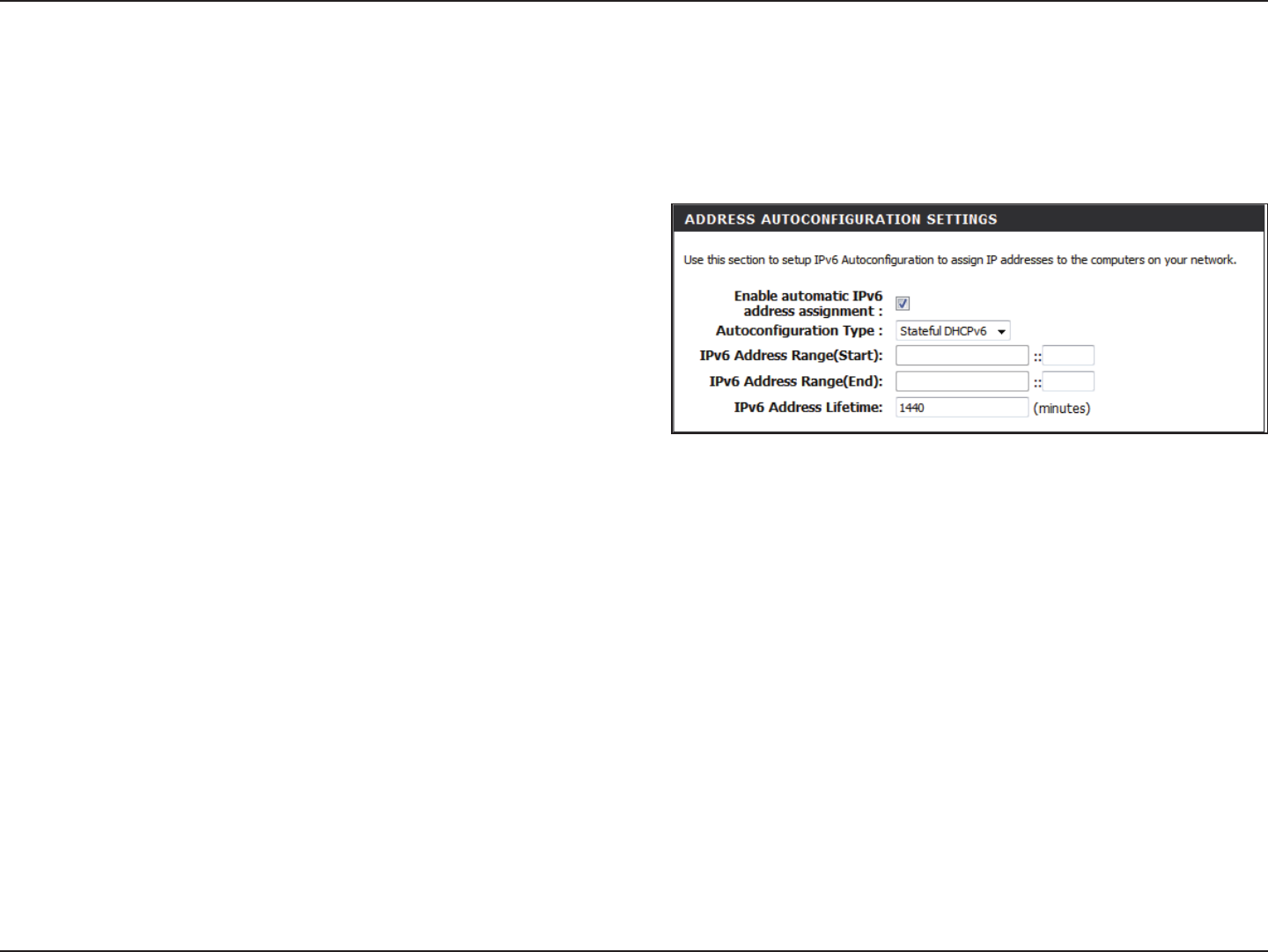
72D-Link DHP-1320 User Manual
Section 3 - Conguration
IPv6
Autoconguration (Stateless/DHCPv6) - Stateful
To congure the Router to use a Static IPv6 Stateful connection, congure the parameters in the LAN Address Autoconguration
Settings section as described below:
Check to enable the Autoconguration feature.
Select the Stateful(DHCPv6) option from the drop-down
menu.
Enter the start IPv6 Address for the DHCPv6 range for your
local computers.
Enter the end IPv6 Address for the DHCPv6 range for your
local computers.
Enter the IPv6 Address Lifetime (in minutes).
Enable automatic
IPv6 address
assignment:
Autoconguration
Type:
IPv6 Address Range
Start:
IPv6 Address Range
End:
IPv6 Address
Lifetime:
Click the Save Settings button to save any changes made.

73D-Link DHP-1320 User Manual
Section 3 - Conguration
IPv6
6to4
Select 6to4 from the My IPv6 Connection is drop-down menu if your Router will use a 6 to 4 tunnel to connect to the Internet.
Enter the DNS Address supplied by your Internet provider
(ISP).
Enter the LAN (local) IPv6 address for the router.
Primary DNS
Address:
LAN IPv6 Address:
Click the Save Settings button to save any changes made.
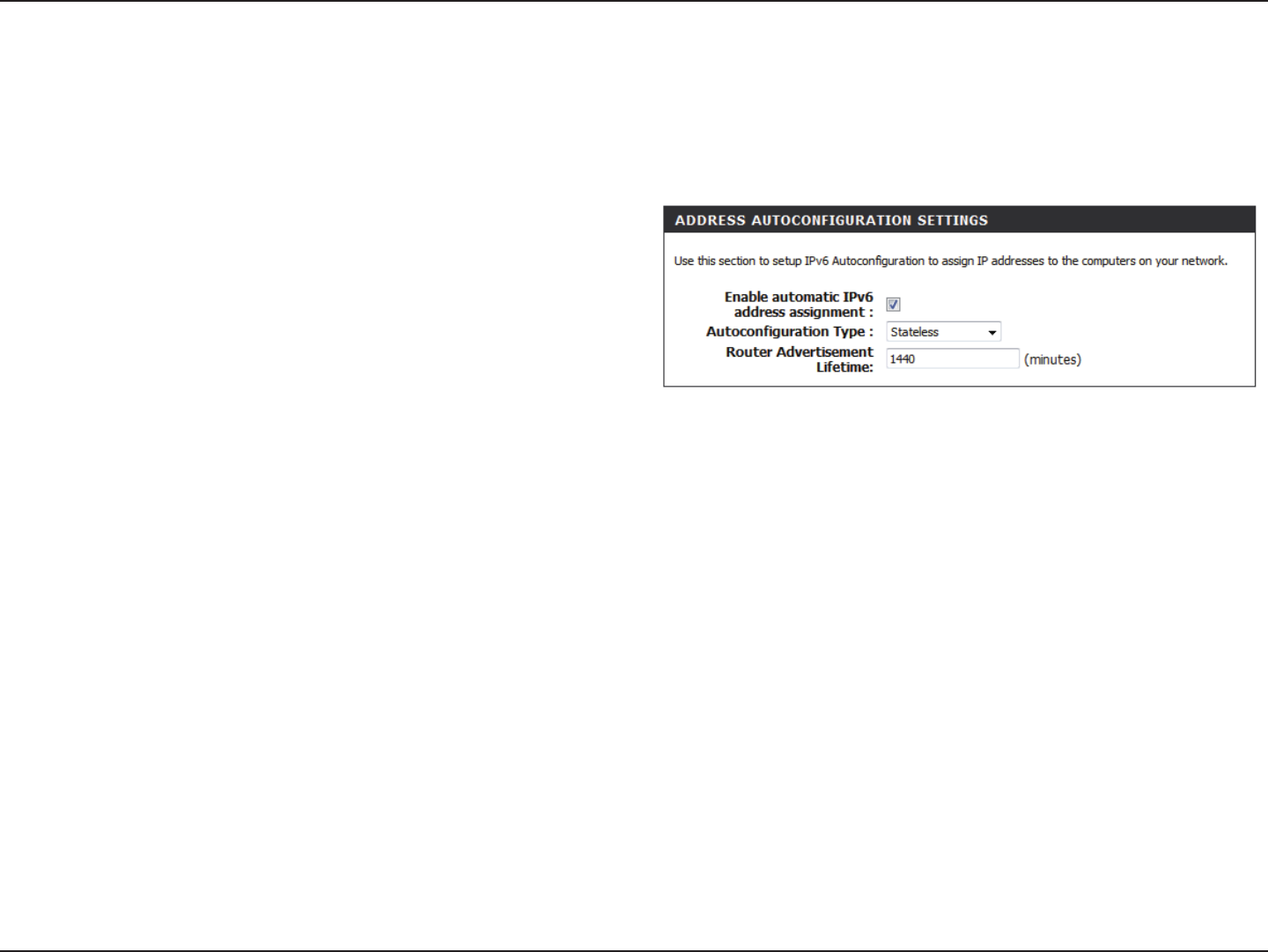
74D-Link DHP-1320 User Manual
Section 3 - Conguration
IPv6
6to4 - Stateless
To congure the Router to use an IPv6 to IPv4 tunnel stateless autoconguration connection, congure the parameters in the
LAN Address Autoconguration Settings section as described below:
Check to enable the Autoconguration feature.
Select the Stateless option from the drop-down menu.
Enter the Router Advertisement Lifetime (in minutes).
Enable automatic
IPv6 address
assignment:
Autoconguration
Type:
Router
Advertisement
Lifetime:
Click the Save Settings button to save any changes made.

75D-Link DHP-1320 User Manual
Section 3 - Conguration
IPv6
6to4 - Stateful
To congure the Router to use an IPv6 to IPv4 tunnel stateful autoconguration connection, congure the parameters in the
LAN Address Autoconguration Settings section as described below:
Check to enable the Autoconguration feature.
Select the Stateful option from the drop-down menu.
Enter the start IPv6 Address for the DHCPv6 range for
your local computers.
Enter the end IPv6 Address for the DHCPv6 range for
your local computers.
Enter the IPv6 Address Lifetime (in minutes).
Enable automatic
IPv6 address
assignment:
Autoconguration
Type:
IPv6 Address
Range Start:
IPv6 Address
Range End:
IPv6 Address
Lifetime:
Click the Save Settings button to save any changes made.
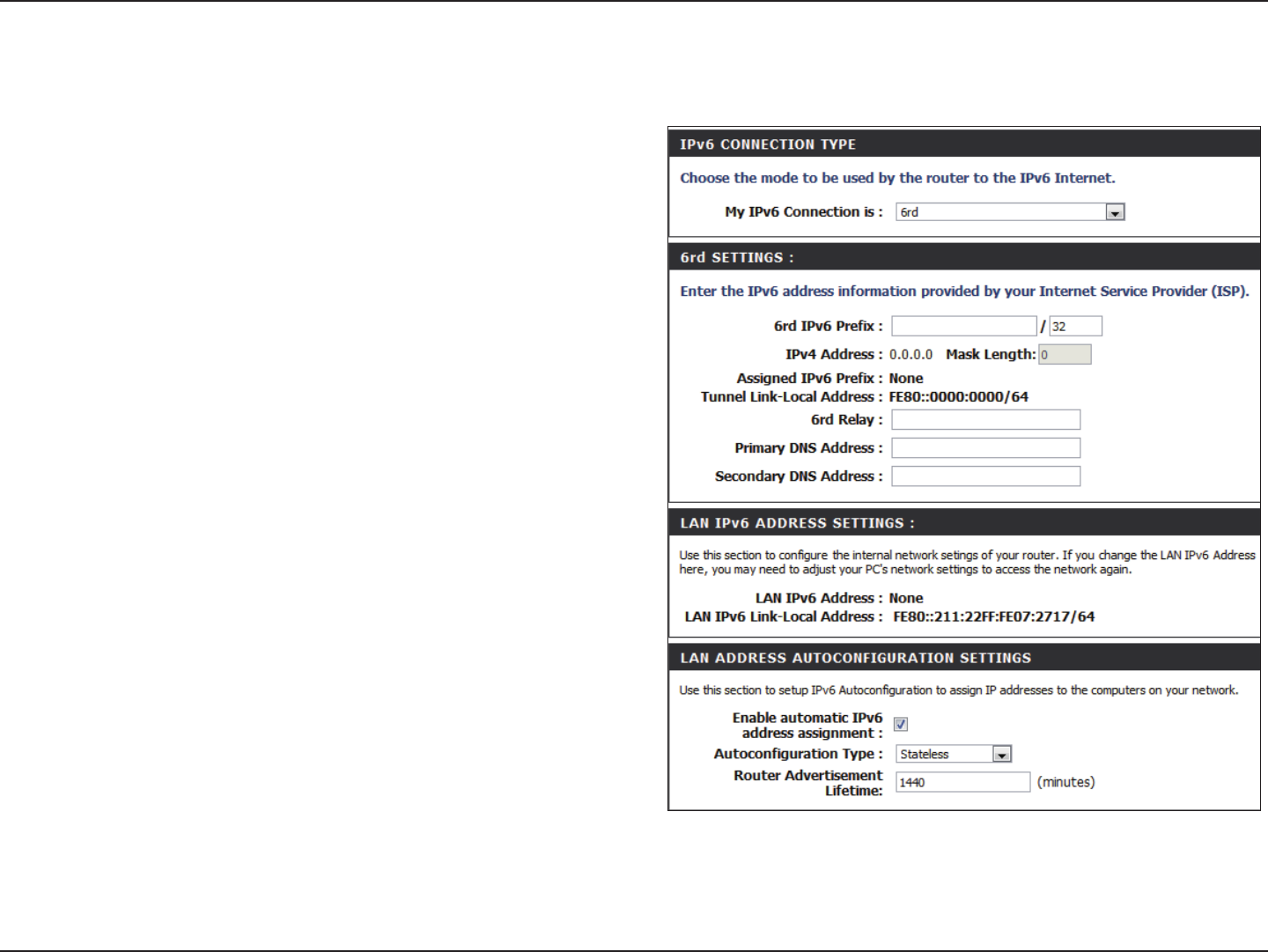
76D-Link DHP-1320 User Manual
Section 3 - Conguration
IPv6
My IPv6
Connection:
6rd IPv6 Prex:
LAN IPv6 Address:
Select 6rd from the drop-down menu.
Enter the settings supplied by your Internet provider (ISP).
Enter the LAN (local) IPv6 address for the router.
6rd

77D-Link DHP-1320 User Manual
Section 3 - Conguration
6rd (Stateless)
Check to enable the Autoconguration feature.
Select the Stateless option from the drop-down menu.
Enter the Router Advertisement Lifetime (in minutes).
Enable automatic
IPv6 address
assignment:
Autoconguration
Type:
Router
Advertisement
Lifetime:
Click the Save Settings button to save any changes made.
IPv6

78D-Link DHP-1320 User Manual
Section 3 - Conguration
6rd (Stateful)
Check to enable the Autoconguration feature.
Select the Stateful DCHPv6 option from the drop-down
menu.
Enter the start IPv6 Address for the DHCPv6 range for
your local computers.
Enter the end IPv6 Address for the DHCPv6 range for
your local computers.
Enter the IPv6 Address Lifetime (in minutes).
Enable automatic
IPv6 address
assignment:
Autoconguration
Type:
IPv6 Address
Range Start:
IPv6 Address
Range End:
IPv6 Address
Lifetime:
Click the Save Settings button to save any changes made.
IPv6
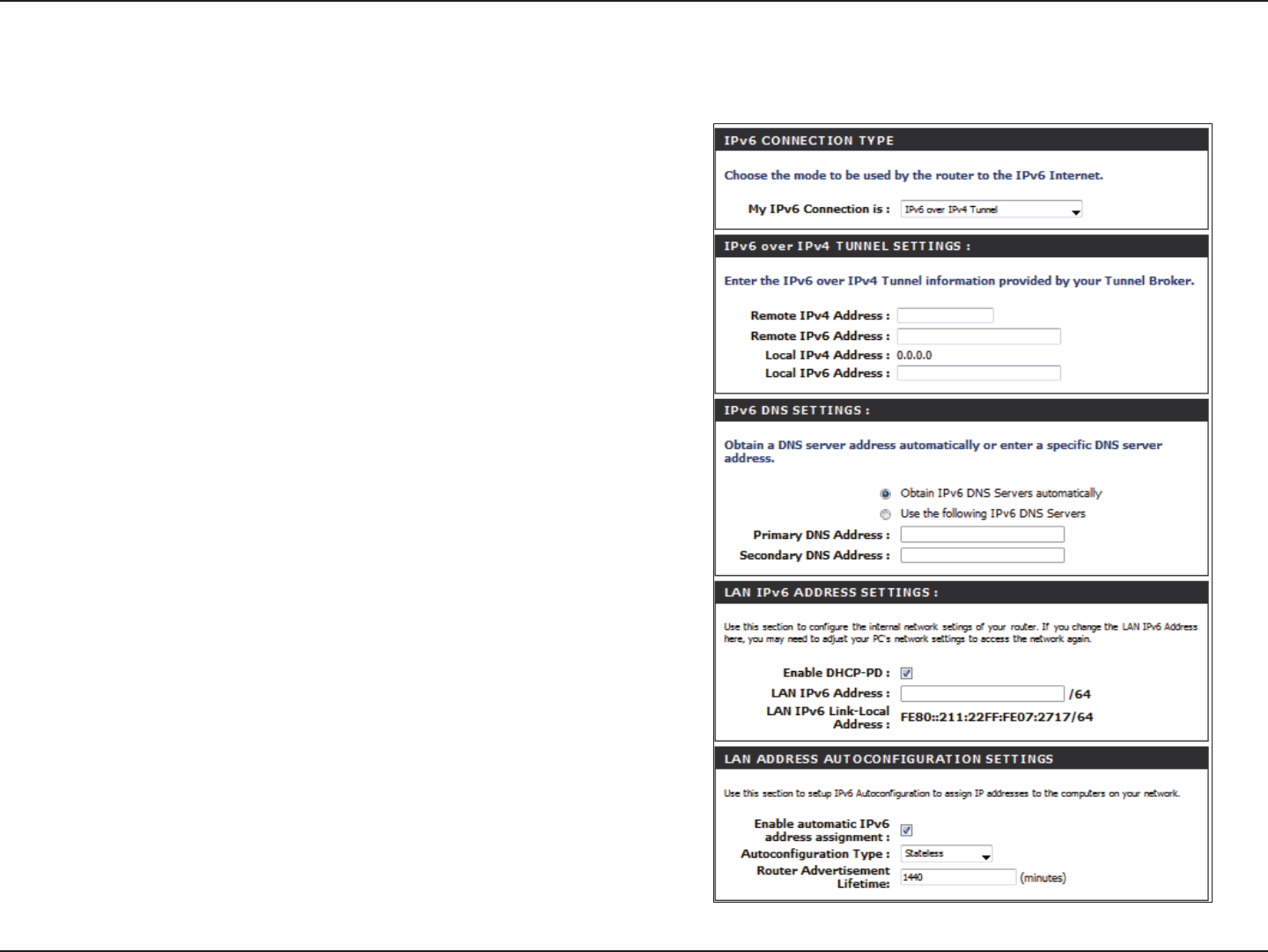
79D-Link DHP-1320 User Manual
Section 3 - Conguration
IPv6 over IPv4 Tunnel
Select IPv6 over IPv4 Tunnel from the drop-down
menu.
Enter the IPv6 settings supplied by your Tunnel Broker.
Obtain a DNS server address automatically or enter a
specic DNS server address.
Enter the primary and secondary DNS server addresses.
Enter the LAN (local) IPv6 address for the router.
My IPv6
Connection:
IPv6 over IPv4
Tunnel Settings:
IPv6 DNS Settings:
Primary/Secondary
DNS Address:
LAN IPv6 Address:
IPv6
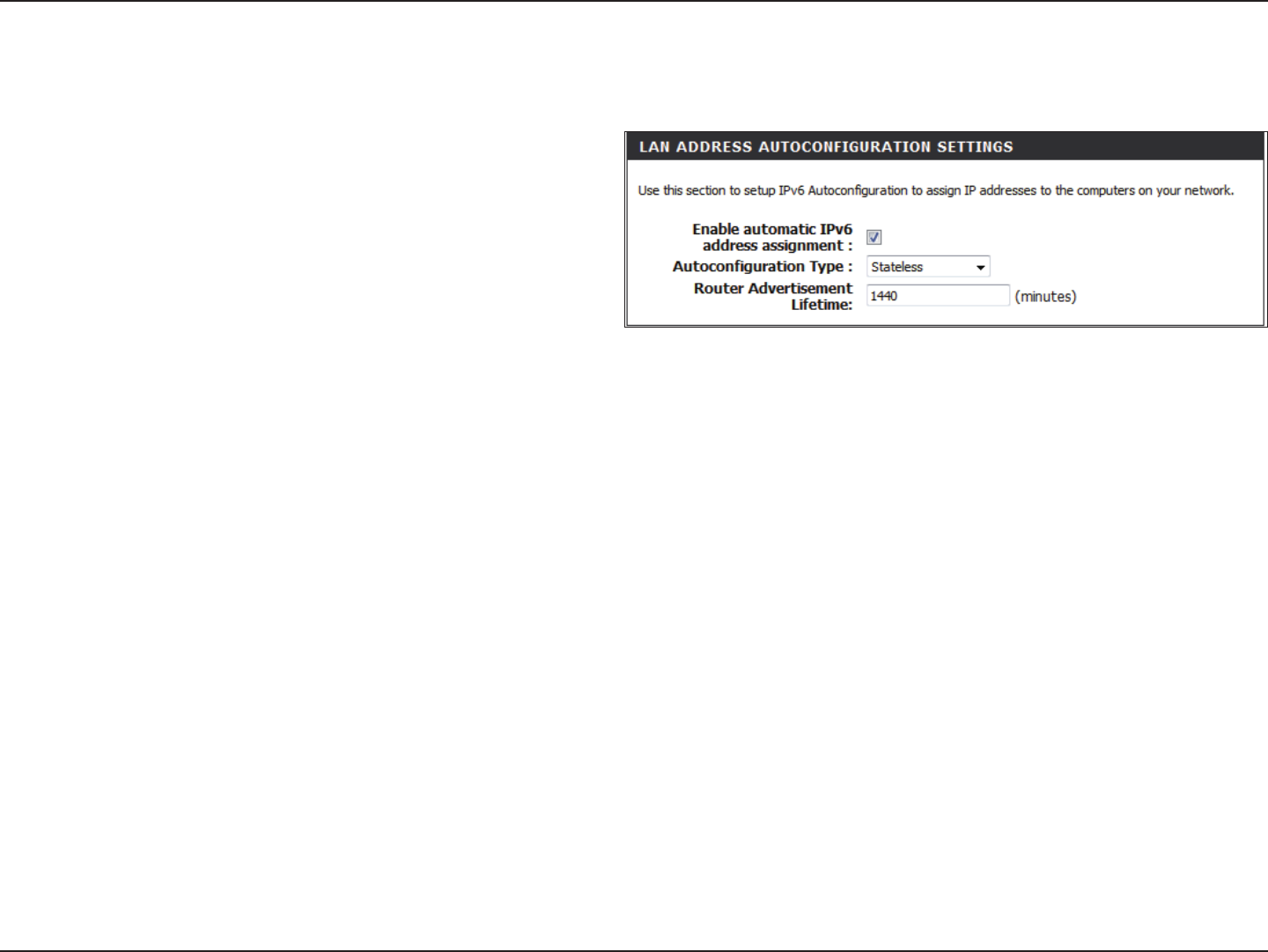
80D-Link DHP-1320 User Manual
Section 3 - Conguration
IPv6 over IPv4 Tunnel - Stateless
Check to enable the IPv6 address assignment
feature.
Select Stateless. Refer to the previous page for
Stateful.
Enter the Router Advertisement Lifetime (in
minutes).
Enable automatic
IPv6 address
assignment:
Autoconguration
Type:
Router
Advertisement
Lifetime:
IPv6